- A Visit from the Goon Squad Summary

by Jennifer Egan
These notes were contributed by members of the GradeSaver community. We are thankful for their contributions and encourage you to make your own.
Written by Timothy Sexton
It is 2008 and Alex and Sasha are out on what will prove to be their single date. When Sasha excuses herself to use the restroom her compulsion to take things that do not belong to her overwhelms and she steals the wallet. After watching the woman come out and frantically search for the missing item, Sasha heads back to the bathroom and is discovered red-handed. She begs the woman not to say anything and she agrees. Alex and Sasha head back to her apartment which is overrun with stolen items and have. Sex.
The year is 2006 and middle-aged record executive Bennie Salazar is trying yet again to make a connection with son Chris. On this occasion, the attempt involves visiting a band called the Stop/Go sisters.
The year is 1979 and carefree teenager Bennie Salazar loves hanging out with Rhea, Jocelyn, Scottie and Alice doing the whole sex, drugs and punk rock and roll thing. Scottie has it bad for Jocelyn, but Jocelyn enters into a relationship with an man named Lou Kline that she met while hitchhiking.
The year is 1973 and Lou Kline is a middle-aged music producer in Africa on safari with his kids and girlfriend. An encounter between Charlie, the 14 year old daughter, and a young warrior briefly gives a peek into the future of 2008. Later the safari members will witness the killing of a lion. Later, another glimpse into the future reveals a sad narrative for Charlie: brief membership in a weird Mexican cult, a cocaine addiction resulting the need for facial reconstruction surgery and a history of being dominated by men.
Twenty years after first meeting him, Jocelyn visits a dying Lou at his home, tagging Rhea along. By now, Lou’s kids number six and his marriages stopped after number three. When it slips Jocelyn’s mind that his first son Rolph is dead and she inquires about him, Lou begins to cry and Jocelyne slips into into a silent simmering anger that culminates with her assertion that she should kill him right now. He responds that it is too late.
The year is 199 and Bennie is a successful enough music producer to be featured in a piece published in Spin magazine. Scottie has not enjoyed nearly the same trajectory and reads the article in a bitter mood. He goes to visit Bennie in his office, but the meeting is awkward. As he leaves, he stops and hands Bennie’s card to a couple he recognizes who are pursuing a career in music.
Over the course of 2002-2004 Bennie and his wife Stephanie take up residence in a rather conservative suburb where their rock and roll attitudes are not exactly a perfect fit. To try to better assimilate, they apply for membership and accepted into a country club. Thing go much better for Stephanie who make a friend of Kathy, but Kathy’s husband Clay insults Bennie one night a party. Bennie washes his hands of the whole country club lifestyle, but Stephanie keeps it up behind his back. Time drags on and when a washed-up rocker named Bosco arrives to inform them of his plans for a comeback tour, the lies threaten to catch up with Stephanie, but as he madly rushes to keep her life in balance, she discovers that Bennie has been lying too: he’s been having an affair with Kathy.
The year is 2008 and Dolly live in an apartment with her daughter trying to desperately to regain her footing as a hotshot NYC PR maven. At present, however, her entire client list consists of just one dictator given to indulging his genocidal tendencies. Dolly arranges for a movie star nearly as washed up as she to be photographed with the General—as he is known—but the mouthy movie star goes too far, causing the General to kidnap her and send Dolly and her daughter back home. When Dolly publishes the picture of the General and the movie star, both experience a spike in popularity.
Written in the format of a celebrity puff piece in 1999, the former kidnap victim, Kitty Jackson tells all to reporter Jules Jones. Jules is brother to Stephanie and brother-in-law to Bennie.
Chapter 10:
Sasha has a new boyfriend in 1993: Drew. Growing increasingly jealous of Drew is Rob, the boy she entered into a phony romance with to fool the detective hired by her father to follow her and find out what he was doing. Rob relates this to Drew which is news to him and also admits he regrets not sleeping with Sasha when he had the chance. One night Rob and Drew go to a club, get high and then walk down by the river where Rob tell him that Sasha’ past is not nearly as clean-cut as he thinks. Drew accuses Rob of lying and dives into the frigid water of the East River. Rob goes after, but never comes back up.
Chapter 11:
The year is 1991 and it’s been two years since Sasha ran away from home. Her uncle Ted has traveled to Naples to track down her down. When he finds her, she’s got a limp, slash marks across her wrist and the ability to pick his wallet from his pocket without him even realizing it.
Chapter 12:
In the year 2025, Sasha and Drew’s 12-year-old daughter Allison has created a PowerPoint presentation that reveal that Drew is a doctor, that she has an autistic brother a year older and that the house is filled with tension whenever both mother and father are home which is not often because Drew prefer to stay at work for as long as possible.
Chapter 13:
About two years before Allison will create her PowerPoint, 60-ish Bennie Salazar is sitting in the living with a man named Alex who is struggling to remember the name of a girl from whom he first heard of Bennie; all he can recall is that on their one and only date there was some confusion about a stolen wallet or something. Later they go to a concert and after finally getting Scottie to take the stage, Alex watches the performance almost lost in a trance. When Alex finally recalls that the girl’s name was Sasha and he and Bennie walk to the apartment where they wound up after that date. Sasha doesn’t live there anymore.
Update this section!
You can help us out by revising, improving and updating this section.
After you claim a section you’ll have 24 hours to send in a draft. An editor will review the submission and either publish your submission or provide feedback.

A Visit from the Goon Squad Questions and Answers
The Question and Answer section for A Visit from the Goon Squad is a great resource to ask questions, find answers, and discuss the novel.
Study Guide for A Visit from the Goon Squad
A Visit from the Goon Squad study guide contains a biography of Jennifer Egan, literature essays, quiz questions, major themes, characters, and a full summary and analysis.
- About A Visit from the Goon Squad
- Character List
Essays for A Visit from the Goon Squad
A Visit from the Goon Squad essays are academic essays for citation. These papers were written primarily by students and provide critical analysis of A Visit from the Goon Squad by Jennifer Egan.
- A Visit into the Minds of the Goon Squad
- “Pure Language” and the Dirtying of Technology in Egan's Novel
- Fish as Symbols for the Acceptance of Reality in 'A Visit from the Goon Squad'
- To Save Time in a Bottle: Confronting the Past and Distorting Reality with Scottie, Robert, and Bennie
- Egan, Sasha, and Questionable Adulthood: The Downfall of American Democracy as Told by Punk Rock
A Visit from the Goon Squad
By jennifer egan.
‘A Visit from the Goon Squad’ is a spellbinding multi-genre book by the iconic American novelist, Jennifer Egan. The book was published to huge acclaim in 2010 and won the highly coveted Pulitzer Prize Award.
About the Book

Article written by Victor Onuorah
Degree in Journalism from University of Nigeria, Nsukka.
From a postmodernist standpoint and written into thirteen solid chapters, with each able to stand alone as a complete, single story, Egan’s ‘ A Visit from the Goon Squad ’ explores how people, society, and culture phase out in the presence of time. This gripping – yet complex – tale touches on the experiences of the different caliber of characters , all harmonized by the rock music era of the 70s.
Key Facts about A Visit from the Goon Squad
- Book title: A Visit from the Goon Squad
- Author: Jennifer Egan
- Publisher: Knopf Doubleday
- Release Date: June 2010
- Page count: 278
- Genre: Psychological Fiction. Novel. Short story collection
- Climax: None clear climax or resolution
- Setting: New York City, San Francisco, Italy.
Jennifer Egan and A Visit from the Goon Squad
Jennifer Egan’s journey to become the author of the monumental, Pulitzer Prize-winning book ‘ A Visit from the Goon Squad ’ is interesting and can’t be labeled straightforward.
The author’s literary road started out not so much as the regular spot popular authors did. To start with, Egan didn’t write from an early age. Her childhood wasn’t nearly as tranquil as most children would have because she moved around a lot with her mother (after her parents divorced when she was only two years old).
Novel writing wasn’t even in the top two dreams for Egan as she began coming of age. Her first passion was archeology and the author did take a year off after high school to explore that aspiration but it wasn’t going to be. Her next stop was modeling and the reason was probably not so tied to passion as it was hinged on the fact that she possessed a tall, model-slim frame.
After a couple of modeling trips to California and later to Japan, Egan returned to Pennsylvania and got enrolled in college, but would, after a first-year college break, take a trip to New York City and try to make something – still – from modeling. However, her booking days were less than enough to even pay for an apartment, so she left her career and concentrated on her college program.
Graduating college with a class of 85 with a degree in English Literature no doubt laid the groundwork for her later writing success – given that she had now been knowledgeable with literature theories and the art of good creative writing. Before penning her first novel ‘ The Invisible Circus ,’ first explored the terrains of mainstream journalism – publishing several award-winning articles for the New York Times Magazine.
Egan’s ‘ A Visit from the Goon Squad ’ came in June 2010 as the author’s fourth book after ‘ The Invisible Circus ,’ ‘ Look at Me, ’ and ‘ The Keep.’ The book took a non-conventional approach in the genre, narrative style, characters, and technique, exploring the passage of time (how time just never stops for anyone) – in the rock music world.
The book, even though not an instant commercial smash hit, garnered several positive reviews from top publishers and critics. The following year after its official release, it won a number of awards – including the Pulitzer Prize after impressing the literary community. Even after more than a decade after the release of ‘ A Visit from the Goon Squad, ’ and with the author having published other award-winning books, Goon Squad is still powering strong as Egan’s finest work to this day.
Books Related to A Visit from the Goon Squad
‘ A Visit from the Goon Squad ’ has been called a complicated and intimidating read by its critics for its sheer defiance of the rules of regular prose-type novel writing. Initially written as a thirteen-short story series for mainstream print publication, the book was later published by Knopf as a unified novel in 2010 and designed as fiction.
Despite being widely called fiction, ‘ A Visit from the Goon Squad ’ is generally considered – even by the author herself – as a book that is (in addition to being fiction) experimental and uncategorizable. The book covers the exuberant lifestyle and struggles of punk music-loving teenagers and the overall punk rock music industry.
Every story in ‘A Visit from the Goon Squad ’ is gripping and captivating in itself – forming an independent narrative of their own while also having at their tail ends the right story transitioning techniques to help blend the thirteen stories in a single narrative.
The book is one of the most innovative books since the 2010s given that it’s studded with several unique literary techniques – among which are the use of non-linear narrative style, and a multi-perspective storytelling technique (told in the first, second, and third person). Additionally, the book also includes a whole chapter done in PowerPoint slides – and another in the form of a magazine news article.
While there aren’t many books decorated with such abundant literary features, some books can still be regarded as being similar to Jennifer Egan’s ‘ A Visit from the Goon Squad ’ masterpiece. One that is perhaps more worrisome to be included in this list is ‘ The Candy House ’ – which is a sequel to ‘ Goon Squad ‘ and follows a very similar literary prototype. Octavia E. Butler’s ‘ Kindred ’ is another similar book in this category for the fact it’s more subtle than most books and deals a great deal in a non-linear narrative, including flashbacks and flash-forwards and trips to and fro through time.
The Lasting Impact of A Visit from the Goon Squad
‘ A Visit from the Goon Squad’ is one of the few books whose impact cuts across all readers irrespective of their age, background, and social orientation. This is because it talks about the passage of time and its offsetting effect on people, their dreams , and aspirations. This is a common struggle everyone faces and even at one point or another has been a victim of the goon squad – time.
For younger people, a very important lasting lesson is the need to remember that there won’t always be time to pursue that passion. And that the earlier one starts working on their dreams, the quicker one achieves them, and the happier one becomes when they turn grey and look back in retrospect. The book also carries some vital lessons for older people who might have been a victim of time as it teaches how to move on from a terrible past and make something out of life.
On a literary level, ‘A Visit from the Goon Squad ’ is an enriched work of literature that examines what sway popular cultures – such as music and social media technology – have on the younger generations (with the book exploring the 70s through the 2020s). Academically, the book’s relevance shows in its inclusion as part of a course syllabus, while for the general interest reader, it is a mixture of thrills, grips, and spellbinds.
A Visit from the Goon Squad Review ⭐️
Jennifer Egan’s ‘A Visit from the Goon Squad’ is innovatively written across different writing styles – effectively transitioning from newspaper article style to short stories collection style to novel writing style. The book is genuinely complicated, but is also a worthwhile read with loads of introspective lessons to be learned.
A Visit from the Goon Squad Historical Context 📖
Jennifer Egan’s ‘A Visit from the Goon Squad’ has at least three historical events that set the mood for the overall plot; the terror attack of the World Trade Center in 2001, the 1970s San Francisco punk rock era, and the advent of social media and the internet.
A Visit from the Goon Squad Best Quotes 💬
The inevitability of time is one unchanging aspect of reality that Jennifer Egan’s ‘A Visit from the Goon Squad hammered severely on. All her many characters – major and minor – are impacted by this phenomenon and there’s certainly more than a few admonitions for readers to pick out from the best quotes offered by the book.
A Visit from the Goon Squad Character List 📖
‘A Visit from the Goon Squad’ features an array of characters from different times, but core to these characters are the troubled Sasha Blake and rock music exec Bennie Salazar.
A Visit from the Goon Squad Themes and Analysis 📖
In ‘A Visit from the Goon Squad,’ Jennifer Egan tries to explore the theme of time and how quickly it can flash before our eyes, often leaving us reminiscing about some good memories from the past or regretting having lived less than we planned to.
A Visit from the Goon Squad Summary 📖
‘A Visit from the Goon Squad’ by Jennifer Egan follows a multi-style narration where some are done in the first person, some in the second, and others in the third person. The book consists of 13 chapters and each tells a complete, independent story with a different protagonist of its own.
It'll change your perspective on books forever.
Discover 5 Secrets to the Greatest Literature
There was a problem reporting this post.
Block Member?
Please confirm you want to block this member.
You will no longer be able to:
- See blocked member's posts
- Mention this member in posts
- Invite this member to groups
Please allow a few minutes for this process to complete.
Advertisement
Supported by
To Their Own Beat
- Share full article
By Will Blythe
- July 8, 2010
If you’re like me, you tend to regard plot summaries as a necessary boredom at best. They’re the flyover country between a reviewer’s landing strips of judgment, revealing almost nothing about the way a book actually works, almost nothing about why it succeeds or fails. If plot were the crucial measure, there’d be no difference between a story about the fish that got away and “Moby-Dick.” Reading such summaries (or writing them) is usually as beguiling as listening to some addled fan of “Lost” explain what happened on that botched rune of a show.
At least this is how I felt until I read Jennifer Egan’s remarkable new fiction, “A Visit From the Goon Squad.” Whether it is a novel or a collection of linked stories is a matter for the literary accountants to tote up in their ledgers of the inconsequential. What’s actually kind of fun for once, however, is attempting to summarize the action of a narrative that feels as freely flung as a bag of trash down a country gully. That’s because to do so captures Egan’s essential challenge to herself: How wide a circumference can she achieve in “A Visit From the Goon Squad” while still maintaining any sort of coherence and momentum? How loosely can she braid the skein of connections and still have something that hangs together?
There is a madness to her method. She hands off the narrative from one protagonist to another in a wild relay race that will end with the same characters with which it begins while dispensing with them for years at a time. The book starts with Sasha, a kleptomaniac, who works for Bennie, a record executive, who is a protégé of Lou who seduced Jocelyn who was loved by Scotty who played guitar for the Flaming Dildos, a San Francisco punk band for which Bennie once played bass guitar (none too well), before marrying Stephanie who is charged with trying to resurrect the career of the bloated rock legend Bosco who grants the sole rights for covering his farewell “suicide tour” to Stephanie’s brother, Jules Jones, a celebrity journalist who attempted to rape the starlet Kitty Jackson, who one day will be forced to take a job from Stephanie’s publicity mentor, La Doll, who is trying to soften the image of a genocidal tyrant because her career collapsed in spectacular fashion around the same time that Sasha in the years before going to work for Bennie was perhaps working as a prostitute in Naples where she was discovered by her Uncle Ted who was on holiday from a bad marriage, and while not much more will be heard from him, Sasha will come to New York and attend N.Y.U. and work for Bennie before disappearing into the desert to sculpture and raise a family with her college boyfriend, Drew, while Bennie, assisted by Alex, a former date of Sasha’s from whom she lifted a wallet, soldiers on in New York, producing musicians (including the rediscovered guitarist Scotty) as the artistic world changes around him with the vertiginous speed of Moore’s Law.
All of the above takes place in 13 chapters covering 40 years or so, ranging backward and forward across time, each composed from a different point of view, which means 13 different centers, 13 different peripheries. And yet everything hangs together, connected by a tone of simmering regret arising from love’s wreckage and time’s relentless devouring.
Is there anything Egan can’t do in this mash-up of forms? Write successfully in the second person? Check. Parody celebrity journalism and David Foster Wallace at the same time? Check. Make a moving narrative out of a PowerPoint presentation? Check. Write about a cokehead music producer who demands oral sex from his teenage girlfriend during her friends’ band’s performance? Check. Narrate another chapter from the perspective of the above girlfriend’s best friend, standing at the same performance on the other side of said producer? Check. Compose a futuristic vision of New York? Check.
Although shredded with loss, “A Visit From the Goon Squad” is often darkly, rippingly funny. Egan possesses a satirist’s eye and a romance novelist’s heart. Certainly the targets are plentiful in rock ’n’ roll and public relations, the twinned cultural industries around which the book coalesces during the period from the early ’80s to an imagined 2019 or so. No one is beyond the pale of her affection; no one is spared lampooning. Often she embraces and spears her subjects at the same time. Moved to ecstasy by the singing from a convent, Bennie signs the nuns to a record contract, only to blow the deal when, in a moment of boyish enthusiasm, he kisses the mother superior flush on the lips. This is one of many “shame memories” he is dredging up.
Egan’s depiction of Jules, the celebrity journalist, embodies her sophisticated sympathy. Such types are normally easy prey for fiction writers, cheap signifiers of corruption. But Egan understands that the manufacture of image in the modern world is as routine as the assembly of Model T’s in the old industrial economy. Which is to say it’s done by regular people like you and me, not villains but folks just trying to get by. Here she parodies not only the celebrity profile Jules writes but his effort to break away from a hackneyed genre and compose an original piece. It’s probably the only such profile where (a) the author is writing from jail and (b) he confesses to the attempted rape of his subject. Jules is stymied, however, when the starlet under scrutiny stabs him with a miniature Swiss Army knife as they roll around on the lawn in Central Park. “I think I’d have to call that the end of our lunch,” he concedes.
Likewise, Egan writes with pointed affection for the disgraced P.R. executive La Doll, who, desperately in need of work, starts freelancing for a genocidal general in the tropics. First she tries to soften his image by dressing him in teal blue caps with fuzzy flaps; then she enlists the actress victimized in Central Park, also down on her luck, in a scheme to fawn over the general and make him smile, revealing an unseen tender side. The actress embraces the general and then, showing more spine than expected, berates him in front of his men. “Do you eat them?” she asks the dictator about his victims. “Or do you leave them out so the vultures can do it?” Is this a photo-op or what?
In such a world, the children have to grow up fast. Where J. D. Salinger’s kids are all precocious little Zen masters, too innocent for the treacherous adult world, Egan’s are cold-eyed observers of their parents’ deficiencies, judging grown-ups with the severity of a kangaroo court. Of La Doll’s daughter, passing through military checkpoints, Egan writes: “She met the eyes of the machine-gun holders with the same even look she must have used to stare down the many girls who had tried in vain, over the years, to unseat her.”
For a book so relentlessly savvy about the digital age and its effect on how we experience time (speeded up, herky-jerky, instantaneous, but also full of unbearable gaps and pauses), “A Visit From the Goon Squad” is remarkably old-fashioned in its obsession with time’s effects on characters, that preoccupation of those doorstop 19th-century novels. Hanging over Egan’s book is a sense that human culture is changing at such warp speed that memory itself must adapt to keep pace.
The last chapter, which literalizes this sense perhaps a little too much, depicts a futuristic New York, in which babies signal their consumer choices with handsets and audiences are manipulated by selected enthusiasts known as “parrots.” Here Egan attempts to bring a centrifugal narrative full circle, which, given the entropic exhilarations on display, isn’t really in keeping with the story’s nature. But this is perhaps the only shortcoming (and a small one at that) in a fiction that appropriately for its musical obsessions, is otherwise pitch perfect.
A VISIT FROM THE GOON SQUAD
By Jennifer Egan
274 pp. Alfred A. Knopf. $25.95
Will Blythe is the author of “To Hate Like This Is to Be Happy Forever.”
Explore More in Books
Want to know about the best books to read and the latest news start here..
What can fiction tell us about the apocalypse? The writer Ayana Mathis finds unexpected hope in novels of crisis by Ling Ma, Jenny Offill and Jesmyn Ward .
At 28, the poet Tayi Tibble has been hailed as the funny, fresh and immensely skilled voice of a generation in Māori writing .
Amid a surge in book bans, the most challenged books in the United States in 2023 continued to focus on the experiences of L.G.B.T.Q. people or explore themes of race.
Stephen King, who has dominated horror fiction for decades , published his first novel, “Carrie,” in 1974. Margaret Atwood explains the book’s enduring appeal .
Do you want to be a better reader? Here’s some helpful advice to show you how to get the most out of your literary endeavor .
Each week, top authors and critics join the Book Review’s podcast to talk about the latest news in the literary world. Listen here .
The Goon Squad Gets Old
Do Jennifer Egan’s tricks still work?

I n 2010 , Jennifer Egan published A Visit From the Goon Squad . The novel won the Pulitzer Prize and the National Book Critics Circle Award, suggesting esteem among populists and highbrows alike. Commentators praised its combination of technical virtuosity—the intricate cogs and wheels that connected plotlines across time and geography—and sentimental “heart,” a wistful emotional atmosphere piped in like a gas to keep the mechanism from rusting.

Explore the April 2022 Issue
Check out more from this issue and find your next story to read.
Racing back and forth in time (between the 1970s and the 2020s), the book found its center in the chastened view from middle age. The chapters took the protagonists from their 40s—when they were already in decline after appearing on the culture’s radar as moguls, musicians, publicists, journalists influential in the recording industry—to their hopeful beginnings in high-school-band rehearsals and college-dorm musings. The effect was to accentuate the melancholic gap between ambition and actuality.
The puzzle-box precision in the ordering of chapters—and the narrative medley, varying past and present tense, first and third and even second person—turned an ordinary generational portrait into a mosaic. Glimpses of the main action through the eyes of minor characters (some deranged, some children) supplied the glue.
The approach called out for thematic justification, and the literary techniques suggested technologies of the moment. Egan’s epigraph was from Proust, but The Goon Squad proposed Google and Facebook as inspiration, and “the wish-fulfillment fantasy these portals offer: What ever happened to … ? ” Meanwhile, at the edges of scenes, surveillance cameras, the internet, post-9/11 national-security paranoia —the invasions of public recording—were at work unsettling the realm of private recording: the intimate pop-music soundtracks of individuals’ lives. The Goon Squad seemed to promise deeper significance because the novel was also reading the news.
Egan bills her new book, The Candy House , as a “ sibling novel ,” a curious bit of nomenclature. It seems to mean that she trundles out The Goon Squad ’s methods to try them again. Calling it a sequel is more accurate; at least I can’t imagine rewards to its readers that don’t include renewing acquaintances with old friends. Here, in chapters that span roughly the 2010s to the 2030s, Egan unspools subsequent events in the lives of The Goon Squad ’s principals—the record executive Bennie Salazar; his mentee, Sasha Blake; and his mentor, Lou Kline (the original three generations)—accoutered with spouses and innumerable unhappy offspring. Egan continues to incorporate each generation’s peer groups from school and work, and now we see the youngest children as adults.
Ratcheting up the technology, The Candy House fully embraces a science-fiction conceit, and implies that some of Egan’s minor Goon Squad characters not only invented social media and seized control of music streaming, but have made good on a new technology, Own Your Unconscious, which uploads the totality of each participant’s memories to the cloud. It includes a Collective Consciousness feature that allows users access to others’ recollections, and some chapters are presented as the product of consulting “gray grabs” from multiple recorded minds—yet they read like ordinary third-person narratives.
From the November 2017 issue: Jennifer Egan’s surprising swerve into historical fiction
Egan makes no use of the further innovations, and Rashomon -style effects, that such a capacity would seem to enable, and that even the simplest sci-fi novel would explore. Surely the experience of entering another person’s consciousness, or multiple consciousnesses separately experiencing the same event, poses questions: Do all thoughts and memories speak the same language? Do you behave differently, knowing that everything you think can be recovered? Not addressed. The invention amounts to a new plot point, not a fictional evolution.
But something big has changed in the characters’ fates. This time, we keep company with a cast of winners, superspies, Special Ops assassins, and world-historical gatekeepers. Gone are the poignant emotional swerves and empathy for sad sacks elicited by The Goon Squad . A journey that had seemed bittersweet, plaintive, familiar yet refreshed by Egan’s singularly convoluted narrative construction—like jazz standards burnished with brilliant arrangements—now sounds depthlessly manic, like sped-up Muzak. It’s as though Egan’s ingenious technique has been streamlined for short attention spans.
Egan’s feat in The Goon Squad was to have worked out a contemporary means of reconstructing slimmed-down, swiftly moving “ M.F.A. fiction ” to provide jolts of very rare, very special narrative effects, almost exclusively available in very long traditional novels. And she proved she could do this in chapter after chapter, each one sculpted like a crisp short story.
The unique pleasures delivered in long books are unforgettable enough that every reader will likely have his own catalog, and some instances are quite famous. One pleasure arises when a forgotten minor character returns unexpectedly to divert the plot, years after his role seemed at an end. (It happens memorably in different volumes of Balzac’s The Human Comedy , as in The Black Sheep , when the belligerent brother, Philippe, returns to foil the new bully menacing our hero.)
Another occurs when a protagonist absorbs an antagonist’s understanding of an event long after its reality seemed fixed, revising our conception of what has transpired. (So, at the start of Proust’s Remembrance of Things Past , a young Marcel interprets Gilberte’s indecent gesture in the garden at Tansonville as a rejection; five volumes later, she corrects him, letting him know that her hand signal meant he should join her in sexual games with the other children of the neighborhood.) Still another pleasure is discovering a character’s ironic fate years after a pivotal drama. (Hence, in Tolstoy’s War and Peace , the thrill when Prince Andrei, mortally wounded after the Battle of Borodino, is unwittingly lifted onto Natasha’s caravan, hundreds of pages after these characters’ engagement to be married was broken.)
Duration, the sense of having shared in so much eventfulness, seems essential to these transporting experiences of uncanny knowledge. It stands in stark contrast to the most basic effect the novel counts upon: a reader’s fastening onto a narrator, any “I” or restricted point of view, immediately and habitually. Make a character’s perspective ours, and our emotional allegiance is astonishing. Her belief is ours, her shame is ours, her fear, her will. Identification kicks in with even the thinnest characterization.
Using her chronology-scrambling technique in The Goon Squad , Egan demonstrated a shortcut to delivering long-range pleasures, those intense, rare pangs of retrospect and return. She bypassed the kind of unbroken biography of heroes that ordinarily requires many more pages, and instead offered porthole glimpses of her protagonists as seen by peripheral characters.
Each of these observers was given a tic, motif, or symbolic compulsion to distinguish and vivify his or her narration. Those signatures included kleptomania and mild paranoia, a penchant for summarizing the action in anthropological lingo, and family conflict as seen through a child’s PowerPoint presentation. Egan drew on our bottomless reservoir of sympathy for anyone whose perspective we temporarily inhabit, stimulating the same melancholy response, over and over, as she dramatized each minor character’s sorrow at his or her failed understanding, miscommunication, incomplete knowledge of the bigger drama.
The Goon Squad brilliantly hewed to a narrow band of emotions, principally disappointment, regret, shame, and unrequited longing, which were well served by the crosscutting and temporal discontinuity. Nonreciprocal crushes structured the foreground. Rhea wants Bennie, but “Bennie is waiting for Alice, who’s waiting for Scotty, who’s waiting for Jocelyn.” The dynamic recurs a generation later: Sasha trusts Rob, who pines for Drew, who loves Sasha. Behind this, Egan replayed the same primal, sentimental scene of a son or daughter, a wife or lover, unable to gain true or exclusive attention from a “selfish, devouring man,” the father—whether he’s a record-company executive or, in a strange interlude, a genocidal dictator in an unnamed foreign country.
The repetitive formula of brief characterization made all tenses and persons and modes of writing essentially equivalent, producing enjoyable shivers of regret. The chapter rendered as a child’s PowerPoint slides was the celebrated example. Readers marveled that such a skeletal form could still bring them to tears. This seemed a kind of magic—which it was, but less through sorcery than mechanical sleight of hand. The lesson seemed to be that, once the emotional elements were set in place, it really made no difference to us whether the result was written-through.
The upshot was a satisfying dose of sentimentality, in the form of a particular fantasy quest: After all the pain and loss, could modern fathers become faithful and child-centered? The Goon Squad ended in an otherwise mystifying sci-fi vision of apocalyptic reconciliation. In a climate-change-spooked New York City, all music became music for children, who made their desires known through smartphone-like “handsets.” Scotty, the failed rocker of Bennie’s generation, triumphed at last with a children’s concert, and the alpha males of the book made peace with being middle-aged (“You grew up … just like the rest of us”), and were ready to go looking for the women they’d never appreciated, who were not to be found.
T he Candy House knows the techniques of The Goon Squad , but doesn’t recognize the limits of their strengths. It is like Samson after a haircut. To make her mode work previously, Egan had to address regret, failure, decline. She needed to feature the piquant memories of losers who, like all of us mortals, grow up to be something less than the heroes our youthful selves imagined we’d be. This time around, her major characters win and win and win. If inspiration or direction eludes them for a bit, most still win again.
The new novel opens with Bix Bouton taking a lonesome walk. When last we saw him in The Goon Squad , he was a graduate student in computer science. He is now in effect a fictional Mark Zuckerberg. His company is called Mandala, not Facebook; he has colonized Manhattan, not Menlo Park; he is loved, not hated. At least the book doesn’t hate him. It apologizes for his creation of an encompassing capitalist social network by making him Black. Online, he was certain, racism would be overcome. (The novel does not revisit this point.) His big achievement behind him, Bix feels lost, wondering whether he can revolutionize the world again.
He puts on a disguise and wanders into an interdisciplinary gathering of academics, including Ted Hollander, last seen in The Goon Squad as a dispirited art-history professor and Sasha’s benevolent uncle. Luckily, academics are full of good ideas, and a “Brazilian animal studies professor” informs Bix that she and her lab colleagues have begun uploading animal consciousnesses to computers. Eureka! The seeds of Own Your Unconscious are planted.
The next chapter focuses on one of Ted’s sons, Alfred. He has a Goon Squad –style obsession (authenticity) and a tic (screaming bloody murder in public, to jolt bystanders out of their phony social roles). Seeking a recovery of the past that will somehow restore him to wholeness, he travels with his girlfriend to visit Jack Stevens, the only authentic, free, what-you-see-is-what-you-get kid he knew in high school. Jack—older, paunchy, divorced—lives in a crappy suburb, drinks beer, looks at the beauty of the sunset, and desperately loves his kids; his true worry is losing custody. Sunsets, children: “Alfred wanted to sit there forever.” The screamer is released from his obsession, finally at home in the world.
These chapters signal the old dynamic. The powerful producer reaches middle age—will he realize that his achievements are hollow? Will the middle generation be freed from its compulsions and resentments, bringing the elders the truth that family, children, and suburban evenings are what matter?
Yet unlike The Goon Squad , The Candy House goes all in on the celebrity fantasia and undermines the ordinariness. Bix isn’t the only old friend who is doing rather well. Sasha, who fled the music industry to become a craft-focused homemaker in the California desert, is now a world-famous land artist. Global collectors beat a path to her door. Mindy, who was getting her Ph.D. in The Goon Squad , discovered the fundamental algorithms that power all social media. Her daughters patented and sold the algorithms to finance their takeover of the music industry as it moved to online streaming. “Most of the music you hear passes through my hands,” one of them tells us, “and I’ve absorbed innumerable companies along the way.”
Even newly met characters in this book soar, becoming rich and famous. We finally encounter Bennie’s mother, whom we had known only as an impoverished single mom of five and an immigrant from Honduras. Now she is a bitcoin success story who “cashed out at the top of the market, netting untold millions.”
The sad sacks of this installment are Ted’s various children, but none is sad for very long. Miles, the eldest, is a top lawyer and yuppie who becomes a drug addict and pauper, then turns his life around and becomes a state senator. Ames, the ignored middle child, takes off for a career as a Special Ops sharpshooter and assassin, then gets to retire to his childhood home and reminisce. What really matters is the walk-off grand slam he hit in a Little League game in the suburbs as a child, and the love of his dad, who kisses his sweaty head. “ ‘What now, slugger?’ he asks. ‘Anything you want.’ ” These are the book’s last lines—touching, I suppose, though a Little League miracle hardly registers as such when The Candy House ’s characters bestride the world.
In a novel where almost everyone’s luck has turned good, Egan’s reach for the heartstrings loses its plucking power. To compensate, she introduces satirical diversions that explore technology’s challenge to fiction. First she conscripts Chris Salazar, Bennie’s son and a freshly minted Stanford English grad. The CEO of an “entertainment start-up” has hired him to turn stock elements of movies and TV into algebra. The company’s computers will optimize, rationalize, and monetize the world’s narratives, as Mandala has done for consciousness. Chris’s savior is a “raffish outsider” on a Harley-Davidson, who awakens him to the weirdos, misfits, and junkies outside tech’s “cushy citadel.” Cue Mondrian, Chris’s counter-start-up for freedom, an “invisible army of data defiers.”
The next satire might as well be a product of the entertainment start-up’s narrative-generating software. Lulu, the adorable self-possessed child from The Goon Squad , has grown up to be a Bionic Woman–like “citizen agent.” Her chapter, “Lulu the Spy, 2035,” outdoes Egan’s earlier PowerPoint presentation. It’s composed in epigrams (the book’s promotional copy calls them “tweets”), dictated by our heroine to her mind-reading military brain implant. The mission is straight from Bond films (or Get Smart ), as Lulu cozies up to international criminals in their luxurious Mediterranean villas. It’s pulp techno-kitsch of a singularly giddy kind, because her handlers have equipped her with awkward transmitters implanted in every part of her body. (“A button is embedded behind the inside ligament of your right knee … Depress twice to indicate to loved ones that you are well and thinking of them.”)
As this campy futurology takes over, the novel culminates in a fantasy of reconciliation between “stories” and “tech,” played out, naturally, as a father-child drama. As Bix, the tech daddy, lies dying, he makes a secret alliance with Chris, the metaphorical rebel son, and leaves a huge bequest of Mandala wealth to Mondrian. Bix’s real son, Gregory, a stymied novelist, had left the family: “Nothing could change Gregory’s belief that Own Your Unconscious posed an existential threat to fiction.” Now he realizes that, viewed the right way—from a free storytelling mind—online archiving of memory gives a writer more material. Social media and cloud consciousness were really “his father’s parting gift: a galaxy of human lives hurtling toward his curiosity … He was feeling the collective without any machinery at all. And its stories, infinite and particular, would be his to tell.” He’ll finish his novel after all.
Like a new-age George Eliot, Egan steps in to anoint this revelation with an authorial apothegm: “Only Gregory Bouton’s machine—this one, fiction—lets us roam with absolute freedom through the human collective.” I confess this ending stirred the old melancholy in me. You cannot proclaim the novel a winner, in a cardboard contest between tech and tales, while whirring along yourself on stock elements and toothless satires of bad movies. At her best, Egan has been the inventor of algorithms of rich complexity, stimulating core human yearnings through technical devices. Trying them again, but this time to evoke a triumphal register of emotions, she has proved the pertinence of Silicon Valley gospel to her fiction: To keep her audience spellbound, sitting still won’t work. She’ll have to innovate.
This article appears in the April 2022 print edition with the headline “The Goon Squad Gets Old.” When you buy a book using a link on this page, we receive a commission. Thank you for supporting The Atlantic.
When you buy a book using a link on this page, we receive a commission. Thank you for supporting The Atlantic.
A Visit from the Goon Squad

82 pages • 2 hours read
A modern alternative to SparkNotes and CliffsNotes, SuperSummary offers high-quality Study Guides with detailed chapter summaries and analysis of major themes, characters, and more. For select classroom titles, we also provide Teaching Guides with discussion and quiz questions to prompt student engagement.
Chapter Summaries & Analyses
Chapters 1-2
Chapters 3-4
Chapters 5-6
Chapters 7-9
Chapters 10-11
Chapters 12-13
Character Analysis
Symbols & Motifs
Important Quotes
Essay Topics
Discussion Questions
When she first appears in A Visit from the Goon Squad , Sasha is in therapy for her kleptomania, having lost her job and her friends, presumably as a result of her condition. We eventually learn that she has had an abusive childhood and her adolescence involved self-destructive behavior. She runs away at seventeen and travels the world for two years, before returning home and going to college. At NYU, she meets Rob, her best friend who accidentally drowns in the East River shortly after his attempted suicide. She also meets and starts dating Drew, who witnesses Rob’s drowning and is unsuccessful at trying to save him. After many years apart, Sasha and Drew reconnect and are “married late” (233); they have two children, Alison and Lincoln. At the end of the novel, Sasha makes sculptures out of objects from her family’s daily life, items that are “casual and meaningless” (265).

Don't Miss Out!
Access Study Guide Now
Related Titles
By Jennifer Egan

Manhattan Beach
Jennifer Egan

The Candy House

Article Contents
Replaying the past in eat the document, mapping the pause in a visit from the goon squad, rewind and fast-forward, conclusion: the sound of time passing, works cited.
- < Previous
Play It Again: Reading the Contemporary through Music in Jennifer Egan’s A Visit from the Goon Squad and Dana Spiotta’s Eat the Document
- Article contents
- Figures & tables
- Supplementary Data
David Hering, Play It Again: Reading the Contemporary through Music in Jennifer Egan’s A Visit from the Goon Squad and Dana Spiotta’s Eat the Document , Contemporary Women's Writing , Volume 15, Issue 2, July 2021, Pages 244–259, https://doi.org/10.1093/cww/vpab034
- Permissions Icon Permissions
In this article, I argue that Jennifer Egan’s A Visit from the Goon Squad (2010) and Dana Spiotta’s Eat the Document (2006) use music as a way to problematize postmodern approaches to history and temporality. Using Giorgio Agamben’s model of “the contemporary,” I argue that Egan and Spiotta stage an intergenerational dialogue by contrasting the listening habits of parents and children and thus enabling, in Agamben’s words, a “meeting place” between generations that recovers an understanding of duration through the shared act of experiencing music, one that can provide a clearer temporal view of the past and of possible futures.
When you and I were younger, you could buy a new record and have an hour spare to listen. You find the hour now. Any kid. They’re either on the internet, texting each other on their telephones, playing games or they’re watching music on the interminable number of digital channels. . . . So where do you even have the time to stop and listen to a CD? (Barfe 344)
In 2004, this prediction by Sony executive Muff Winwood about the decline of the music business was being echoed throughout the industry. Record companies had witnessed a vertiginous plunge from the high point of 1999, when rising global music sales hit $38.5 bn, to a 7% drop in value in 2002 (Barfe 323). The first decade of the twenty-first century saw unprecedented turbulence in the industry, with album sales dropping in all but one year (Schilling). This crisis was the culmination of a series of corporate misjudgments. The major record companies, swollen after the spate of mergers and acquisitions that followed Bill Clinton’s Telecommunications Act of 1996, bullishly ignored the emergence of peer-to-peer illegal music-sharing networks until the Recording Industry Association of America eventually responded in December 1999 with a massive lawsuit, holding file-sharing site Napster liable for copyright infringement (Menn 124). The crisis brought with it a sense of profound generational dislocation, with Winwood’s assertions about the differences of young people’s listening habits mirrored in the cultural conflict between corporations and online entrepreneurs; Napster’s Shawn Fanning was just eighteen when he developed the first version of the website.
The same decade also saw the emergence of a number of American novels that drew heavily upon the music industry, including Michael Chabon’s Telegraph Avenue (2012), Jonathan Franzen’s Freedom (2010), and Jonathan Lethem’s The Fortress of Solitude (2003). 1 The “rock novel,” a term coined in 2013 by critic Florence Dore, 2 is characterized by a number of tropes: music in transitional state from physical object to digital file; relationships as mediated through music; and the inheritance of the countercultures of the 1960s—the era when rock and roll became a global youth phenomenon—and their impact on a new generation. In fact, these texts might more usefully be described as contemporary rock novels, as they are not the first iteration of the form; there are antecedents such as Bret Easton Ellis’ Less Than Zero (1985) and Nick Hornby’s High Fidelity (1996), as well as numerous rock music references in the works of Thomas Pynchon. However, the specific concerns of the contemporary rock novel have their clearest origins in the postmodernism of Don DeLillo’s Great Jones Street (1973). Framed by the disappearance of Dylan-style rock musician Bucky Wunderlick, DeLillo’s novel is located at the intersection of drug culture, hippy communes, and domestic terrorism in the aftermath of 1960s counterculture. Wunderlick, burned out from success, finds that making music has led to a kind of stasis, telling an interviewer that “the more I make people move, the closer I get to personal inertness” and that “music puts me just so out of everything” (DeLillo 101, 45); his final music before his exile consists of a song, “Pee-Pee-Maw-Maw,” with lyrics consisting of infantile babble (114). Wunderlick soon becomes caught up in an elaborate deal involving a compound that paralyzes the language centers of the brain—a drug that, at the climax of the novel, is tested on him.
DeLillo’s focus on the drift toward inertness, silence, and dislocation stages Fredric Jameson’s “suggestive aesthetic model,” in Postmodernism, or the Cultural Logic of Late Capitalism , of the atrophied relationship between past and present in postmodernity as a form of “schizophrenia,” presenting the subject as “reduced to an experience of pure material signifiers, or, in other words, a series of pure and unrelated presents in time” (27). Jameson sees this represented in the aesthetics of the postmodern as an emphasis on “discontinuity” in temporality. He illustrates this with a musical example; the work of composer John Cage, in which “a cluster of material sounds . . . is followed by a silence so intolerable that you cannot imagine another sonorous chord coming into existence and cannot imagine remembering the previous one well enough to make any connection with it if it does” (28). Similarly, DeLillo describes Wunderlick as being “wedged in a block of time, trying to avoid the feeling that time is stretchable” (117), while elsewhere Wunderlick’s previous life on the road is characterized as “one blank plane of unsegmented time” (132). This is a characteristically postmodern existence, one which drifts toward physical and verbal paralysis as the culmination of the novel’s plot.
The contemporary rock novel, conversely, emerges at the time when the baby-boomer generation, so strongly associated with the music of the 1960s, begin to reach late middle age, with their own children entering adulthood. These novels occupy a position both adherent to and distant from the rock and roll era, and their work has a strong preoccupation with aging and obsolescence; the narratives, located in an era when aging boomers listen nostalgically to music from their youth and with the recording industry in an apparently terminal state of decline, embed music within broader frames of cultural finitude, dislocation, and intergenerational conflict. Accordingly, the novels often operate a doubled mode of temporality, with the length of the song itself being mapped onto historical or generational time. This moves both backwards, uncovering the cultural amnesia of America’s troubled colonial history, and forwards, toward an engagement with a future in which the boundedness of the song or generation is set against the potential finitude of humanity itself.
These contemporary novels are also responding to the era of postmodernism that produced novels such as Great Jones Street . These are, then, not themselves postmodern works but instead texts that have necessarily incorporated the cultural inheritance of postmodernism. The principal response to postmodernism in these novels is a focus on the problem of time and temporality, with the rock song itself occasioning a series of narrative structures that respond to, and in some cases attempt to debunk, a postmodern sense of atemporality and generational dislocation. In the two novels discussed here, Jennifer Egan’s A Visit from the Goon Squad (2010) and Dana Spiotta’s Eat the Document (2006), an intergenerational discourse based around rock music stages an inquiry into and a subsequent rebuttal of atemporality in favor of a new structure which affords a dialogue with, and emancipation from, that endless postmodern present described by Jameson.
I use the term “contemporary” for these new novels because it speaks most forcefully to the temporal and cultural problems they address and the era in which they are located. Crucially, the contemporary is frequently described in relation to the problems of periodization in an era characterized by the so-called “end of history.” Wendy Brown sees the political landscape of this era as a time of fundamental discontinuity, where “it is a rare thinker . . . who straightforwardly invokes the premise of progress” (6). This moment is instead, according to Brian McHale, an “interregnum, a time between” (334), a pause or caesura between postmodernism and whatever comes after. Periodizing the contemporary is, then, as Theodore Martin argues, “a conceptual problem” (2). As a possible solution to this temporal uncertainty, Martin suggests that “any historical account of the contemporary moment must serve simultaneously as a theory of how that history is written” (6). In order to examine how Spiotta and Egan address this complex temporal problem, I want to turn to another theorist of the contemporary, Giorgio Agamben.
Agamben begins his essay “What is the Contemporary?” by considering Nietzsche’s concept of Unzeitgemässe from Untimely Meditations . Nietzsche, says Agamben, defines those who “truly belong to their time” as those who “neither perfectly coincide with it nor adjust themselves to its demands” (40). Agamben amends this model, moving away from a state of disconnection and toward a definition of contemporariness as “a singular relationship with one’s own time, which adheres to it and, at the same time, keeps a distance from it” (41). He illustrates this model by invoking Osip Mandelstam’s poem “The Century,” which describes the century as a “beast” with a “shattered” backbone that is nevertheless paradoxically trying to “look back” to contemplate its tracks (Agamben 42–43). Into this scenario comes a speculative figure, “the poet,” who will approach this contorted beast and “weld together with his own blood / the vertebrae of two centuries” (42). Agamben suggests, in accordance with his model of the contemporary, that this poet is both connected to the century-beast and separate from it: “The poet, insofar as he is contemporary, is this fracture, is at once that which impedes time from composing itself and the blood that must suture this break or this wound” (42; my emphasis).
It is the joint venture between creature and poet that is relevant here; Agamben’s collaborative model, whereby the contemporary is at once connected and separate from his time, suggests that a full engagement with one’s time is necessarily a symbiotic enterprise, a “meeting place” (52). Egan and Spiotta employ temporal structures in their novels that are characterized both by the unreachability of the past and by the possibilities of the future; in these novels, music stages both fracture and suture. This suture is occasioned by the playing of music from an earlier era by a younger generation, a process that simultaneously locates the latter outside of their time (the evocation of the era of the music’s release, for which they were not present) and in the present (the process of listening today), and in both novels this playing of music is the event that relocates characters from an atemporal space. This process recalls Agamben’s description of how the poet must begin to theorize a model of contemporariness by first “splitting it up into several times . . . inscrib[ing] into it a caesura and a discontinuity” (52). Spiotta and Egan dramatize this process through those postmodern concepts of the unmentionable, the atemporal, the aphasic, and the inert, represented in these novels by selective amnesia and the musical pause, transforming them instead into dialogic spaces of communication. In these novels, this process creates that “meeting place”—one that is not only fundamentally collaborative but also, crucially, “an encounter between times and generations”, specifically parents and their children (52). In this sense, these texts dramatize Agamben’s concept of contemporariness as containing the chronological past in the manner of “the child in the psychic life of the adult” (50), framing it as an act of intergenerational collective labor. 3
It might be most appropriate to describe the reinscribed modes of temporality in these novels as durational . In The Nick of Time (2004), written within a few years of both novels, Elizabeth Grosz seeks to establish a politics of temporality in the early twenty-first century. As part of this project Grosz appeals to Henri Bergson’s concept of duration, wherein we cannot spatially isolate time through differences of degree but instead “relations of succession function to frame relations of simultaneity, and no ‘object’ can be isolated from another or function to include or contain another” (Grosz 182). If we apply this model of duration to that rupture between the postmodern and the contemporary, we can see McHale’s “interregnum” as a generational space that is the occasion for a kind of emancipatory Bergsonian duration; not exactly a “break” so much as a zone where relations are clarified and time is reinvigorated by these “relations of simultaneity,” a temporal model that contrasts sharply with those postmodern “unrelated presents” described by Jameson. In Jameson’s reference to Cage’s music, the postmodern subject is isolated by the experience of listening to music and enters into a sense of temporal suspension similar to DeLillo’s “blank plane of unsegmented time” (132), one set apart from, respectively, the world and the motion of time. This locks the listener into an eternal pause, a silence that obviates the music existing either side of it. Egan and Spiotta dramatize this moment of the paused present differently, staging a contemporary reengagement with that lost time. This durational model of the contemporary need not contradict Jameson’s famous rallying cry in The Political Unconscious to “Always historicize!” (ix); instead, it places the postmodern itself within a durational frame in order to locate and perceive the temporal spaces that have established it and those that can emerge from it.
It is significant that both novels are strongly based around family units. Through this durational model, the history of a family is seen not as a successive spatialized linear chronology but, in accordance with Agamben’s collaborative model, a dynamic temporal zone of relations. Within a family it is possible, through genetic and behavioral factors, to see the past simultaneously in the present, and for the family unit to resemble, in Julia Kristeva’s famous formulation, “less a chronology than a signifying space ” (209). Finally, while similarly motivated, these spaces staged by Egan and Spiotta have distinct temporal outcomes; Spiotta’s reengagement telescopes into an understanding about America’s past, while Egan is ultimately concerned with how this process can help us to understand an uncertain future.
The narrative of Eat the Document alternates between two time periods—1972–80 and 1998–2000. In the former, two domestic insurgents, Mary Whittaker and Bobby DeSoto, become involved in a bombing campaign that results in the accidental death of a housekeeper. They change identities and cut off contact with their families, choosing to live on the run. The latter timeframe presents Whittaker and DeSoto living separately under the assumed names Louise and Nash. Nash’s job at an underground bookstore retains an ideological connection to his former life, while Louise has a son, Jason, a teenage vintage music obsessive who knows nothing of her past and thinks of her as a “corny suburban housewife” (23). Much of the latter timeframe is presented through Jason’s journal, which charts his slow realization that his mother is not who she appears to be.
Throughout Eat the Document , this gradual process of intergenerational understanding is enabled by music. Mary assumes two false names while on the run, both of which refer to songs about a woman lost to time. The first, Caroline, evokes the melancholia of “Caroline, No” by Jason’s favorite band The Beach Boys (“Where did your long hair go / Where is the girl I used to know?”). The second, Louise, recalls the tension created by an absent woman in Bob Dylan’s “Visions of Johanna”: “Louise, she’s all right, she’s just near / She’s delicate and seems like the mirror / But she just makes it all too concise and too clear / That Johanna’s not here”). 4 By encoding Mary’s past identity in the records Jason listens to obsessively in the present, Spiotta establishes music as both fracture and potential suture in their relationship. However, before this suture can occur Jason must surmount the hermeneutic temporal gaps in his adolescent understanding of music. These missed connections are explicitly tied by Spiotta to Jason’s misreading of musical clues to his mother’s past in favor of his cataloging and fetishizing of the musical object itself. This object—the rare 45, the valuable bootleg—proves a barrier to an understanding of his mother’s identity. Jason mistakes his own simulated experience of 1960s music for an accurate portrait of the decade itself, this postmodern simulacrum excluding the lived experiences of his own mother in favor of a constructed pastiche of the sixties. This is reminiscent of Jameson’s argument that for Americans the 1950s is the “privileged lost object of desire” ( Postmodernism 19). For Spiotta, writing in the decade after Jameson, it is the 1960s that have come to embody that “list of stereotypes, of ideas of facts and historical realities” (Jameson, Postmodernism 279).
Spiotta frames this missed familial connection against the music of The Beach Boys, a band featuring four family members (Brian, Dennis, and Carl Wilson, and Mike Love) who became estranged but who were, paradoxically, celebrated for their ability to harmonize. In his journal, Jason is barely ever depicted anywhere other than in his room, an indirect reference, perhaps, to the song “In My Room,” in which Brian Wilson frames the bedroom as “a world where I can go and tell my secrets to” and where one can “laugh at yesterday” (and perhaps by extension yesterday’s significance to today). 5 The dramatic irony enacted by Spiotta’s analeptic and proleptic narrative structure reveals how Jason’s playing of these records creates a sort of temporal blindness, because there is another history of that era hiding in plain sight in his own home: his mother’s true identity. Jason’s initial inability to perceive this is, as per Agamben, a failure to be fully contemporary: “[those] who can call themselves contemporary are only those who do not allow themselves to be blinded by the lights of the century, and so manage to get a glimpse of the shadows in those lights, of their intimate obscurity, its special darkness, which is not, however, separable from those lights ” (Agamben 45; my emphasis). The obscurity of Jason’s mother’s identity, then, is enabled in part by his own imperfect perception; having constructed, via his listening, a simulacrum of the past, he cannot see that his relationship with the music is both a barrier to historical engagement and, simultaneously, the gateway by which it can be accessed.
Jason’s definition of the Beach Boys’ music as an “aural time capsule” (290) recalls the postmodern model outlined by Jameson: an isolated and spatialized “pure and unrelated present” floating free of duration. It is only during a later conversation with his mother, when Louise remarks that she once met Dennis Wilson in a bar, that Jason begins to understand that the musical artifact, that monadic “time capsule,” is in fact the path to engagement with the history of his family. He then acknowledges in his journal that “I’m no genius about people, but something is definitely up” (89). A further moment of understanding, one which directly precedes Jason’s final discovery of his mother’s true identity, involves the playing of another album: Funkadelic’s Maggot Brain . The title track is played by Gage, a record collector and hermit who lives next door to Jason. This sequence itself replays an earlier incident in Louise’s life that precedes this scene in the narrative—when, in the women-only community of New Harmon, the young Caroline hears this track: “The music evoked an underlying loneliness that at first made Caroline sad and then started creeping her out. It occurred to her that the guitar solo might go on forever” (172).
The invocation of eternity here is a source of terror for Caroline, but her son’s experience of the record is disquieting because it begins to synthesize his musical experience with his mother. Initially, Jason defensively couches the record in the record collector’s classification of genre, referring to it as “smokin’ psychedelic funk,” but soon the music becomes “claustrophobic and frightening” and, Gage remarks, with pretend spontaneity, that it sounds “like his mother just died” (212). Gage is in fact passing off someone else’s words here as his own; in this case, George Clinton’s studio instruction to guitarist Eddie Hazel to play “like your momma . . . just died” (Smith). In this moment of replaying Gage’s simulated emotional response serves to reinforce Jason’s disquiet over the unraveling of his own mother’s identity, and immediately afterward he experiences a durational revelation that syntactically mirrors his mother’s reaction to the record nearly three decades earlier: “The wail of guitar got longer, more extended and further from the melody. Did it go on forever? Could it please just return?” (212). This, then, begins to enact the symbiotic relationship to time that is characteristic of Agamben’s contemporary, inscribing a familial or even hereditary emotional response to the music by durationally overlapping Jason and his mother’s experiences.
Jason’s experience with Maggot Brain is followed by fearfulness of the forward movement of time. Returning to his room and listening to The Beach Boys, Jason writes in his journal that “I do not want to go forward , I always want to be carelessly lost in this music. I never want to get sick of it, and I never, ever, want to outgrow this or anything” (212; my emphasis). This is effectively a willed iteration of Jameson’s postmodern subject, one which recalls DeLillo’s Bucky Wunderlick, lost in the moment and unable (or unwilling) to engage temporally. However, Jason is too late to prevent a slow collapse of the barriers between the counterpoint narratives and instead begins to obtain the temporal understanding associated with Agamben’s contemporary. The process of playing the record has occasioned an unwitting synthesis with, or replaying of, emotional reaction from his mother’s past. The source of this reengagement is the same object that had prevented this synthesis from taking place, transfigured from a postmodern simulacrum of the era of production to a durational understanding of the past’s continuous presence in the contemporary.
A Visit from the Goon Squad is structured in two parts, A and B, and the narrative regularly frames the space between these points as a traumatic rupture that is either forgotten or repressed. In the most symptomatic episode, the burnt-out rocker Bosco describes his new album, A to B , as addressing “the question I want to hit straight on: how did I go from being a rock star to a fat fuck no one cares about? Let’s not pretend it didn’t happen” (Egan 127). Egan’s novel is based more directly around the decline of the music industry in the digital era, with the elision of the gap between A and B also mapped on to the lost interval between the A and B sides of a record; while a physical copy of an LP or cassette requires a conscious action to move from A to B, CDs and digital files process this movement silently and without notice. Bosco’s ultimate desire to recoup the repressed time between these points, rather than pretending it didn’t happen, speaks to the way in which Egan’s narrative seeks to churn up and bring lost time (the novel’s epigraph, notably, is from Proust) into contemporary understanding.
This process is most fully enacted in the novel’s penultimate section, “Great Rock and Roll Pauses,” which, like Eat the Document , sets up a dialogue about music between parent and child through the medium of a journal, and also seeks to make visible (or in this case, audible) a forgotten or repressed passage of time in the parent’s life, thus suturing the temporal gap and emphasizing the durational nature of the family. Crucially, “Great Rock and Roll Pauses” also stages a postmodern scenario within a contemporary narrative; Egan dramatizes and interrogates the idea of the desert as a symbol of postmodern atemporality. As with Eat the Document , there is a musical object that appears first as a barrier to this process but is ultimately reconfigured to create an intergenerational understanding. For Spiotta this is the record itself, while for Egan, writing about a largely digital era, it is something less palpable: the pause. Agamben argues that “by means of [a] caesura, this interpolation of the present into the inert homogeneity of linear time, the contemporary puts to work a special relationship between the different times” (52). In their engagement with the pause, the family in “Great Rock and Roll Pauses” employ the caesura in the manner of Agamben’s contemporary, occasioning a dynamic temporal space.
This illumination of the temporal gap between A and B is facilitated by the children of Sasha Blake, the closest Egan’s ensemble narrative gets to a protagonist. Unlike Louise’s past, which is withheld for protection from the law, Sasha’s history is hidden from her children because she does not “trust [her] own memories,” and, in a phrase that echoes Bosco’s sense of dislocation, “it feels like another life” (256). The names of Sasha’s children, Alison and Lincoln, indicate their potential ability to bridge time: Alison’s initials, AB, fuse both points together while Lincoln’s nickname “Linc” suggests connection (235). The family structure is framed for the reader through Alison’s PowerPoint journal, which, unlike Jason’s journal, allows familial and temporal structures to be mapped nonlinguistically. Crucially, the PowerPoint evolves from Sasha’s solo project to a work of collaborative familial labor, as throughout the chapter the diagrammatic form of the journal develops from free-associative to durational.
Like Spiotta, Egan initially employs “In My Room” as an image of dislocation; Alison uses the title for a subsection of her journal (249). On the slide immediately after Sasha’s aforementioned disavowal of her previous life, Alison creates an image of the wall that separates her room from Lincoln’s, with two columns of text, each referring to their respective bedrooms, split by a central rectangular pillar (257). These two monadic, isolated spaces, between which their parents shuttle when saying goodnight, mirror an earlier diagram of the Blake family where Alison depicts herself, Lincoln, and her parents as a Venn diagram of four named circles each of which touches a central circle titled “US,” but not each other (233); this simultaneous fracture and suture hints at the familial strife that will erupt later in the chapter. It is implied that Lincoln is on the autistic spectrum, and he communicates with the family through his cataloging of pauses in rock and roll songs; a data-focused approach that resembles Jason’s categorizing of his own record collection. Alison’s journal represents a collaborative attempt to represent Lincoln’s project visually, but this easy communication between two siblings of the same generation is not mirrored in Lincoln’s relationship with his father, Drew. Alison depicts their strained dialogue in her journal as a process of temporal cause and effect, mapping Lincoln’s thought process and Drew’s failure to engage with it:
Lincoln wants to say/ends up saying:
“I love you, Dad” – Dad is from Wisconsin – I love music – Dad loves me –Steve Miller is from Wisconsin – The Steve Miller Band was popular fifty-something years ago – one of their biggest hits was “Fly Like An Eagle” – “Hey Dad, there’s a partial silence at the end of “Fly Like an Eagle,” with a sort of rushing sound in the background that I think is supposed to be the wind, or maybe time rushing past!” (244)
Alison records a breakdown in communication which results from Drew’s inability to engage with his son on his own terms; he reaches instead for direct signs of emotional response in Lincoln. The dialogue, titled “Dad/Lincoln” with a slash that recalls the interposing barrier between the bedrooms, begins with Drew asking, “Lincoln, before you play another song, I-I’d love to know why the pauses matter so much to you” (275). Lincoln, unable to respond with the emotional directness that Drew craves, instead rapidly reels off data about pauses in songs, at which point Drew loses patience and shouts, “Stop. Please. Forget I asked” (276). The broken syntax of Drew’s response is followed by an emotional response from Lincoln, who begins to cry, and “flinches away and hunches his back into a ball” (277).
Following this incident, Drew asks Alison to come with him for a walk in the desert that surrounds their house. This landscape is a former golf course that has been lost to climate change, with Alison and Drew coming across a field of solar panels which “look evil” but which are in fact “mending the earth” (288). The panels start to move to collect moonlight, and Alison entertains a fantasy that they are a time machine that has transported her forward in time: “that I’m a grown-up woman coming back to this place after many years – living here all together was so sweet – it felt like it would never end” (297). This sequence, and the family drama that precedes it, produces a complex temporal model. The desert has a long history in postmodern thinking as a representative symbol of the denuded or absent real and features in a number of postmodern texts as an important location. 6 With the juxtaposition of this temporally disorienting desert landscape to the motif of the pause, Egan offers a different approach than Eat the Document . While in Spiotta’s novel the playing of a record suggests an “aural time capsule” from which the listener is initially separated, Egan’s use of the pause creates a temporal model in which the pause of the replayed record mirrors the dislocated and barren environment in which the characters reside. The replayed pause has become the most appropriate mimesis of the world, as with Cage’s “intolerable silence” (Jameson, Postmodernism 28) whereby the postmodern subject becomes dislocated from the passage of time; instead of the emotionally engaging sentiment of a song, the process of playing music in Egan’s novel is emptied of content. While Jason’s changing relationship to his records eventually allows him to understand the song as the basis for an intergenerational understanding, nothing can be discovered or mapped from a pause; there is seemingly no content, no model of space or time to recover.
However, as per Agamben, Egan ultimately suggests that this is not strictly true: the mapped pauses do indeed afford understanding and have content, which Lincoln has the privileged ability to identify. His address to his father that the pause in “Fly like an Eagle” contains “a sort of rushing sound in the background that I think is supposed to be the wind, or maybe time rushing past” (244) indicates that not only does the pause have content but also that it has a temporal dimension, one that can be bridged and mapped. It is this ability that makes Lincoln’s playing of pauses, in defiance of his postmodern landscape, commensurate with the inscription of the caesura by Agamben’s contemporary. Agamben’s model of light and darkness bears repeating here:
The contemporary is he who firmly holds his gaze on his own time so as to perceive not its light, but rather its darkness . . . to perceive this darkness is not a form of inertia or of passivity, but rather implies an activity and a singular ability . . . a neutralization of the lights that come from the epoch in order to discover its obscurity, its special darkness, which is not, however, separable from those lights. (44–45)
Lincoln, then, is the contemporary who can map the connection (the “Linc”) between darkness and light. The darkness of the pause is not, of course, inseparable from the “lights” of the song, and Lincoln’s understanding of these elements as temporally connected affords him the possibility of contemporariness, of mapping and therefore understanding the finitude of the pause as something that can be surmounted. This understanding is also profoundly durational : the pause’s existence relies on its simultaneous pro/analeptic relation to distinct temporal components (the song before the pause; the song after the pause) contained within the same object.
However, like Jason in Eat the Document , Lincoln cannot complete this process on his own. Lincoln’s understanding of the pause operates successfully only when integrated into the abilities of the family unit. Immediately after Drew’s argument with Lincoln, Sasha rebukes her husband by shifting his attention away from the pause itself by connecting the end of the pause with the end of the song itself: “The pause makes you think the song will end. And then the song isn’t really over, so you’re relieved. But then the song does actually end, because every song ends, obviously, and THAT. TIME. THE. END. IS. FOR. REAL” (278). This incursion of the “REAL” into a characteristically postmodern model—a dislocated listening practice that takes place within an ahistorical, desert landscape—joins with Lincoln’s understanding to clarify the durational nature of the pause itself. Sasha’s fractured sentence, which syntactically recalls Drew’s angry words to his son, ends instead on the possibility of the real and indicates that a series of discrete linguistic utterances should in fact be understood as a single sentence, each of which needs its corresponding words to operate durationally. Drew then attempts to comfort his son, an action described by Alison as revealing a moment of generational simultaneity: “like watching Dad hug his skinny, long-ago self” (280).
During their trip into the desert, Alison suggests to Drew that Lincoln needs help “graphing the pauses” (285). Drew agrees, and the closing images of the chapter are a series of charts that map the pauses in songs, ending with a slide titled “The Persistence of Pauses over Time,” in which pauses are physically mapped onto a timeline, beneath which is written “The End” (305). These graphs are the result of a collaboration by the whole family: Lincoln’s replaying of pauses, Sasha’s rebuke about the finitude of the pause, Drew’s assistance with graphing, and Alison’s depiction of the graphs in her journal. As in Eat the Document , a durational process is ultimately revealed through a combined, intergenerational effort, but in Egan’s novel this is undertaken by the entire family unit. Understanding the question of contemporariness in these novels, then, requires that collective labor, that “we” indicated by Agamben, dramatized here through a network of different generations to recover a sense of dynamic duration within a postmodern environment of disrupted time.
Finally, I want to gesture toward how that understanding of music’s relation to time in both novels initiates a secondary echo; the contemporary understanding of the “meeting place” that overturns those models of postmodern temporal dislocation also facilitates a broader durational recognition of the playing out of histories that precede and succeed these narratives but are nonetheless essential to an understanding of the contemporary. This is where Spiotta and Egan’s narratives diverge, and where I read both novels as indicating, in their sites of listening, the contemporary importance of understanding the longue durée of American colonial history and the necessity of imagining a human future beyond environmental catastrophe.
In Eat the Document , the contemporary revelation of Louise’s past life is necessarily also a story of historical community, and the willed forgetting that accompanies Louise’s identity is, Spiotta suggests, analogous to a particular kind of blindness over the nation’s past. Jason’s revelation with Maggot Brain is an echo of his mother’s own experience of hearing the record, but the location of Caroline’s listening is equally important and provides its own, broader durational echo. The 1970s women-only community of New Harmon is based around a building constructed in the 1840s by “two renegade New Harmon women,” which is itself an echo of “the original Shaker buildings of the 1790s” (174), and community leader Mother G informs Caroline that “this land has a history of radical alternative community” from those who thought “private property was the root of all evil” (174). When questioned by another resident, Jill, on the community’s absence of men, Mother G cautions against fixating on “the most sensational aspects of what is a much more subtle and sophisticated vision,” arguing that “you cannot base a community on subtraction” (175). Spiotta, though, draws attention to another, unspoken subtraction. As Louise and her friend Berry hike toward the community, they cross “hills that rose up from the Mohawk River,” and when they enter Jill’s living quarters, Louise notices a “platform bed covered in Indian blankets” (170). The community’s location in Herkimer County places it among the territories acquired in 1791 by Alexander Macomb; Macomb’s Purchase, as it was known, involved the buying of land previously surrendered to the state by the British after the Revolutionary War. Before the British purchase, the land had been home to the Iroquois, none of whom were consulted during negotiations. 7 Mother G’s 1970s claim of radical antiproperty community is, therefore, based on the forgetting of an inconvenient past.
Shortly after Mother G’s speech, Caroline ruminates on the possibilities afforded by new life in a passage that explicitly juxtaposes personal and national amnesia:
. . . there is a long history (seldom spoken of in the gloriously amnesiac everyday) in America, and in a democracy, of starting over. It was almost an imperative, wasn’t it? America was founded, of course, by people who invented new lives, who wanted nothing more than to jettison the weight of all that history . . . even if an endless series of beginnings tended to reduce everything to shallow repetition and eliminate any possibility of profound experience. (198–99)
Caroline’s rhetorical question suggests a flawed dialogism—a desire to ask the question but not to receive an answer—which shares Mother G’s amnesia of the true history of American settlement. What she is left with is, in a phrase that recalls Jameson, “an endless series of beginnings . . . reduc[ing] everything to shallow repetition.” It is only through a contemporary intergenerational dialogue with her child that Caroline, reborn as Louise, begins to move beyond this endlessness and blindness by acknowledging responsibility for her past, but Spiotta embeds this within the broader implication of how American colonialism, in its myth of manifest destiny, actively avoids perceiving the presence of the past in the contemporary moment. Adam Kelly argues that what is at stake in the narrative of Eat the Document is “the search for a usable past in order to better understand and address the present”(221), and Spiotta indicates that this understanding must also necessarily involve a historical reckoning that expands beyond the lifespan of the counterculture and those involved in it; the contemporary reframing of the postmodern in Eat the Document suggests ways to think about this broader process. 8
In Jason’s final journal entry, he describes his waning interest in listening to The Beach Boys as “a vacated space” that is now filled with “other things . . . as time goes by” and closes his journal—and the novel—with a rhetorical question: “And that will be something, don’t you think?” (Spiotta, 288, 290). Unlike Caroline, Jason’s question incorporates the possibility of a dialogic partner, a “you” with whom he can discuss what they “used to be” (290). Conversely, the purpose of the journal in A Visit from the Goon Squad is ultimately concerned with the question of imagining a future. During Alison’s return from the desert, she begins to imagine that she is “a grown-up woman coming back to this place after many years.” In this vision, the house she returns to is “a broken-down ruin with no one in it” (296). What sets this apart from Jason’s final journal entry is the projection not into a future of maturity and self-awareness, but rather into a place where humanity has ceased to exist. The juxtaposition here of the musical caesura with the projected end of human civilization recalls Dore’s argument that the rock novel is inherently tied up not only with the question of cultural obsolescence but also with the matter of the Anthropocene. Drawing on Watt’s conception of the novel’s capacity for private orientation, Dore suggests that “rock and roll offers novelists a way to thematize solutions to the crisis of self that humanity’s impending expiration creates. . . . [R]ock novels offer a deflated version of self, a human whose diminishment is a key feature of its new significance.” However, Dore does not address the matter of how this diminishment might change with future generations and how, perhaps, that unifying vision of the contemporary in Egan’s novel might provide a way of thinking beyond, or against, an end of human civilization.
In order to understand this process, it is necessary to return to that earlier synthesis of the pause and Agamben’s “special darkness” (45). Egan locates Lincoln’s focus on the musical pause—his ability to see something when there is apparently nothing there—against a denuded landscape caused by the slow catastrophe of climate change. In this juxtaposition, the ability to see the special darkness of one’s own time and to find a way to bridge the temporal gap is aligned with a capacity to perceive the invisible and durational damage being visited upon the planet by human activity. In Egan’s novel, the younger generation are depicted with the peculiar capability not only to perceive this invisibility but also, through a process of familial cooperation, to enable others to map it. Lincoln’s contemporariness is, in accordance with Agamben, bound up with the ability to perceive certain invisible accretive processes in his own time that will inevitably construct the future. Egan’s novel makes the case that in order to witness and understand our contemporary moment as having a palpable influence on everyone’s future, we need to move beyond a postmodern focus on atemporality toward an intergenerational model of contemporariness whereby we dialogically collaborate to map out and address the existential importance of our durational present.
In the final chapter of Egan’s novel, “fifteen years of war ha[ve] ended with a baby boom” (309), and the communicative gap between generations appears to be widening: young people speak to each other through digital handsets, and infants can download music by simply pointing at it. The latter are referred to as “pointers,” a term that not only incorporates Lincoln’s ability to gesture toward something unseen but also suggests the capturing of that ability by capitalism (309). This final chapter, which occurs in a New York City irrecoverably altered by climate change, is based around a concert by the burnt-out musician Scotty Hausmann, who now performs infantile Bucky Wunderlick-like songs with titles like “I Am a Little Lamb” (331); the concert has been advertised via “parroting” (311), a corporate strategy whereby fake word-of-mouth is disseminated via a “blind team” (315).
These terms of blindness, repetition, and false agency suggest a pessimistic continuation of the historical myopia that Egan and Spiotta caution against, but Egan concludes the novel with a transformative account of the concert itself, which in another notable move away from monadic indoor spaces is now taking place outside and is for an intergenerational audience (Scotty is notably “not wild about enclosed spaces” [322]). Scotty begins the concert by playing his children’s songs before abruptly switching to the old “ballads of paranoia and disconnection” that he wrote many years ago (332). Through this disruptive meeting place of old and new music, played to an audience of multiple generations, the novel offers up a possible model for understanding how music allows us to imagine the contemporary in a communal space. After the concert, the promoter Alex discovers that he, like Lincoln, is now able to perceive “the sound of time passing,” a phrase immediately followed, in the childlike textspeak language of the handset, with:
Th blu nyt Th stRs u cant c th hum tht nevr gOs awy (336)
The proximity of these final observations, with the “stRs u cant c” recalling Agamben’s “special darkness,” points again toward a collaborative model of durational understanding that registers time as “a hum that never goes away” and that, therefore, cannot be subdivided into discrete units. Both Egan and Spiotta, writing about music in the aftermath of postmodern temporal dislocation and in the midst of the industry’s decline, reach toward a model of durational contemporaneity that, in Agamben’s terms, “permits us to grasp our time in the form of a ‘too soon’ that is also a ‘too late’” (47). As Egan puts it, “everything is ending – but not yet” (132).
For a full list of rock novels, see Dore.
Dore coins the term in her Nonsite.org article “The Rock Novel and Jonathan Lethem’s The Fortress of Solitude.”
Agamben stages his own enquiry as a joint enterprise, its success dependent on “our . . . capacity to measure up to this exigency” (39).
The title of Spiotta’s novel also refers specifically to another absence: Dylan’s much bootlegged but never officially released 1966 tour documentary Eat the Document .
Jason does not listen to contemporary music. Any digital apparatus of the late 1990s (such as the nascent battleground of the Napster controversy) is employed strictly for the purposes of finding alternate takes of music from an earlier era, and the notion of digital “sharing” is pointedly absent.
Baudrillard’s pronouncement in Simulacra and Simulation that the postmodern subject lives in “ the desert of the real itself ” (1; emphasis in original) has been strongly influential in postmodern criticism, animating a number of works including Larry McCaffery’s “The Desert of the Real” (1992) and Slavoj Zizek’s Welcome to the Desert of the Real (2002).
For more detail on the history of Macomb’s Purchase, see Schneider.
For more on the question of political responsibility in Spiotta, see Kelly.
Agamben , Giorgio. What is an Apparatus? Stanford UP , 2009 .
Google Scholar
Google Preview
Barfe , Louis. Where Have All the Good Times Gone? The Rise and Fall of the Record Industry . Atlantic , 2005 .
Baudrillard , Jean. Simulacra and Simulation . Michigan UP , 1994 .
Brown , Wendy. Politics out of History . Princeton UP , 2001 .
Chabon , Michael. Telegraph Avenue . Fourth Estate , 2012 .
DeLillo , Don. Great Jones Street . Picador , 2011 .
Dore , Florence . “The Rock Novel and Jonathan Lethem’s The Fortress of Solitude .” Nonsite.org , 20 Jan. 2013 , nonsite.org/article/the-rock-novel-and-jonathan-lethems-the-fortress-of-solitude . Accessed 1 Feb. 2021 .
Dylan , Bob. “Visions of Johanna.” Blonde on Blonde , Columbia Records, 1966 .
———. director. Eat the Document . Unreleased, 1966 .
Egan , Jennifer. A Visit from the Goon Squad . Corsair , 2010 .
Ellis , Bret Easton. Less than Zero . Picador , 2011 .
Franzen , Jonathan. Freedom . Fourth Estate , 2017 .
Funkadelic . “Maggot Brain.” Maggot Brain , Westbound Records , 1971 .
Grosz , Elizabeth. The Nick of Time: Politics, Evolution, and the Untimely . Duke UP , 2004 .
Hornby , Nick. High Fidelity . Penguin , 2014 .
Jameson , Fredric. The Political Unconscious . Routledge , 2002 .
———. Postmodernism, or the Cultural Logic of Late Capitalism . Verso , 1991 .
Kelly , Adam . “Who Is Responsible? Revisiting the Radical Years in Dana Spiotta’s Eat the Document .” Forever Young? The Changing Images of America , edited by Philip Coleman and Stephen Matterson . Universitätsverlag , 2012 , pp. 219 – 30 .
Kristeva , Julia . “Women’s Time.” The Kristeva Reader , edited by Toril Moi . Columbia UP , 1986 , pp. 187 – 214 .
Lethem , Jonathan. The Fortress of Solitude . Faber and Faber , 2005 .
Martin , Theodore. Contemporary Drift: Genre, Historicism and the Problem of the Present . Columbia UP , 2019 .
McCaffery , Larry. , ed “Introduction: The Desert of the Real.” Storming the Reality Studio: A Casebook of Cyberpunk and Postmodern Science Fiction . Duke UP , 1992 , pp. 1 – 16 .
McHale , Brian . “Break, Period, Interregnum.” Twentieth-Century Literature , vol. 57 , no. 3–4 , Fall/Winter 2011 , pp. 328 – 40 .
Menn , Joseph. All the Rave: The Rise and Fall of Shawn Fanning’s Napster . Crown Business , 2003 .
Nietzsche , Friedrich. Untimely Meditations . Translated by R. J. Hollingdale , Cambridge UP , 2012 .
Schilling , Mary Kaye . “The Music Industry in 1998: The Titanic Right Before It Hit the Iceberg.” Vulture , 21 Nov. 2013 , www.vulture.com/2013/11/music-industry-1998-beginning-of-the-end.html . Accessed 1 Feb. 2021 .
Schneider , Paul. The Adirondacks: A History of America’s First Wilderness. Henry Holt , 1997 .
Smith , Caspar Llewellyn . “Funkadelic: Maggot Brain.” The Guardian , 29 Sept. 2011 , www.theguardian.com/music/2011/sep/29/funkadelic-maggot-brain . Accessed 1 Feb. 2021 .
Spiotta , Dana. Eat the Document . Picador , 2006 .
The Beach Boys . “Caroline, No.” Pet Sounds , Capitol Records, 1966 .
———. “In My Room.” Surfer Girl , Capitol Records, 1963 .
———. Smile . Unreleased, 1967 .
Zizek , Slavoj. Welcome to the Desert of the Real . Verso , 2002 .
Email alerts
Citing articles via.
- About Contemporary Women's Writing
- Recommend to your Library
Affiliations
- Online ISSN 1754-1484
- Copyright © 2024 Oxford University Press
- About Oxford Academic
- Publish journals with us
- University press partners
- What we publish
- New features
- Open access
- Institutional account management
- Rights and permissions
- Get help with access
- Accessibility
- Advertising
- Media enquiries
- Oxford University Press
- Oxford Languages
- University of Oxford
Oxford University Press is a department of the University of Oxford. It furthers the University's objective of excellence in research, scholarship, and education by publishing worldwide
- Copyright © 2024 Oxford University Press
- Cookie settings
- Cookie policy
- Privacy policy
- Legal notice
This Feature Is Available To Subscribers Only
Sign In or Create an Account
This PDF is available to Subscribers Only
For full access to this pdf, sign in to an existing account, or purchase an annual subscription.
- International edition
- Australia edition
- Europe edition

A Visit from the Goon Squad by Jennifer Egan – review
T he title of Jennifer Egan's new novel may make it sound more like an episode of Scooby-Doo than an exceptional rendering of contemporary America, but don't be fooled. The book received rave reviews when it was published in the US last year, and for good reason; it has since been named a finalist for several prestigious American prizes. Egan has said that the novel was inspired by two sources: Proust's À la Recherche du Temps Perdu , and HBO's The Sopranos . That shouldn't make sense but it does: Goon Squad is a book about memory and kinship, time and narrative, continuity and disconnection, in which relationships shift and recombine kaleidoscopically. It is neither a novel nor a collection of short stories, but something in between: a series of chapters featuring interlocking characters at different points in their lives, whose individual voices combine to a create a symphonic work that uses its interconnected form to explore ideas about human interconnectedness. This is a difficult book to summarise, but a delight to read, gradually distilling a medley out of its polyphonic, sometimes deliberately cacophonous voices.
The "goon squad" of the title is not itself a reference to The Sopranos : there are no mobsters here. It is one character's name for time: "Time's a goon, right? You gonna let that goon push you around?" Everyone in the book is pushed around by time, circumstance and, occasionally, the ones they love, as Egan reveals with great elegance and economy the wobbly arcs of her characters' lives, their painful pasts and future disappointments. Characters who are marginal in one chapter become the focus of the next; the narrative alternates not only between first-person and third-person accounts, but – perhaps just because she can – Egan throws in a virtuosic second-person story as well, in which a suicidal young man tells his tale to a colloquial "you". She also shifts dramatically across times and places: punk teenagers in 1970s San Francisco become disillusioned adults in the suburbs of 1990s New York; their children grow up in an imagined, slightly dystopic future in the California desert, or attend a legendary concert at "The Footprint", where the Twin Towers used to be, sometime in the 2020s.
The stories circle magnetically around a few characters who recur a bit more frequently than others, and broadly around the American music scene: Lou, a coke-snorting, teenage-girl-seducing music producer in the 1970s, becomes the mentor of an untalented young bass player, Bennie, who becomes a music producer himself, who hires a young woman, Sasha, who has a problem with kleptomania, who sleeps with a young man, Alex, who much later ends up hired by Bennie to engineer the comeback of Bennie's high-school friend Scott, who went off the rails as an adult and ended up one day in Bennie's office with a fish he'd caught in the East River, where Sasha's best friend and boyfriend in college had once gone for an early morning swim with tragic consequences. Bennie's wife works for a publicist named Dolly whose daughter, Lulu, will end up working with Alex; Bennie's wife's brother is a journalist who is arrested for the attempted rape of an actress named Kitty Jackson who has her own fall from grace and is later hired by Dolly to enable the public rehabilitation of a genocidal Latin American dictator.
Each chapter has its own distinct voice and mood, modulating from satire to farce, from melancholy to tragedy. I've never found a description of attempted rape funny before, but when Jules Jones writes (from prison) his account of his assault on Kitty Jackson during an interview, it becomes an uproarious parody of David Foster Wallace that owes more than a little to Nabokov as well, as Jules describes finding himself with "one hand covering Kitty's mouth and doing its best to anchor her rather spirited head, the other fumbling with my zipper, which I'm having some trouble depressing, possibly because of the writhing motions of my subject beneath me." Kitty sprays him with Mace, stabs him in the leg with a Swiss army knife, and runs away. "I think I'd have to call that the end of our lunch," Jules remarks.
If it comes as a surprise that an attempted rape can be hilarious, it is an even greater surprise that a PowerPoint presentation can be moving. Goon Squad becomes more fragmented, and more formally experimental, as it progresses: the penultimate chapter is written entirely as the PowerPoint slide diary of Sasha's teenage daughter Alison, whose brother is obsessed with pauses in rock songs. Those pauses, like the spaces between PowerPoint slides, become a metaphor for the gaps between what we mean and what we say, or the apparently unbridgeable distance between family members. The trick feels appropriate in a book preoccupied throughout by the effects of technology on our lives and culture, from the consequences for music of the digital revolution (as Bennie observes, digital production has transformed not only the industry of music but its sound as well) to the way in which technology is transforming our language. Egan's Orwellian final chapter imagines a future in which English has decomposed into radical text-speak: "if thr r children, thr mst b a fUtr, rt?"
Egan has said that the organising principle of A Visit from the Goon Squad is discontinuity; this may be true, but the reason the book works so well is because of the continuities she has also created: her atomised people collide, scatter and recombine in patterns that are less chaotic than they appear. Egan's characters, and the America they inhabit, are winding entropically down. It's a kind of meditation on the butterfly effect, in which recurrence becomes the measure of the chaos of our lives, the novel reimagined as a series of chain reactions. But Egan's vision of history and time is also decidedly, and perhaps reassuringly, cyclical: the impacts these characters have upon each other are engineered not by coincidence but by connectedness itself, as the people we bump against and bang into become the story of our lives.
Sarah Churchwell is a senior lecturer in American literature and culture at the University of East Anglia
- The Observer
- Marcel Proust
- The Sopranos
- Jennifer Egan
Comments (…)
Most viewed.
WELCOME TO THE FAMILY! Please check your email for confirmation from us.
‘Goon Squad’ officers who tortured Michael Corey Jenkins and Eddie Terrell Parker sentenced in state court
Rankin County Circuit Judge Steve Ratcliff on Wednesday gave the men yearslong state sentences that will run concurrently, or at the same time, as the federal sentences, and the men will serve their time in federal penitentiaries.
- Share on Facebook
- Share on Twitter
- Share via Email
- Copy Link Link Copied
BRANDON, Miss. (AP) — Already sentenced to federal prison, six former Mississippi law enforcement officers who pleaded guilty to a long list of state and federal charges for torturing two Black men were sentenced Wednesday in state court.
The six white former Mississippi law enforcement officers who attacked Michael Corey Jenkins and Eddie Terrell Parker in January 2023 had already been sentenced to federal prison terms ranging from about 10 to 40 years. In March, U.S. District Judge Tom Lee called their actions “egregious and despicable” as he gave sentences near the top of the federal guidelines to five of the six men.
Rankin County Circuit Judge Steve Ratcliff on Wednesday gave the men yearslong state sentences that were shorter than the amount of time in federal prison that they had already received, but longer than what state prosecutors had recommended. Time served for the state convictions will run concurrently, or at the same time, as the federal sentences, and the men will serve their time in federal penitentiaries.

The case drew outrage from top law enforcement officials in the country, including Attorney General Merrick Garland, who said the officers committed a “heinous attack on citizens they had sworn an oath to protect.” In the episode’s grisly details, local residents saw echoes of Mississippi’s history of racist atrocities by people in authority.
The first defendant to be sentenced Wednesday was Brett McAlpin, the fourth highest-ranking officer in the Rankin County Sheriff’s Office. McAlpin had previously been sentenced by a federal judge to about 27 years of federal imprisonment. He was sentenced in state court Wednesday to 15 years on one charge and five years on another.
Prior to the sentencing hearing, Malik Shabazz, an attorney representing Jenkins and Parker, said the state sentencing hearing would be a “test” for Ratliff and state prosecutors.
“The state criminal sentencing is important because historically, the state of Mississippi has lagged behind or ignored racial crimes and police brutality against Blacks, and the Department of Justice has had to lead the way,” Shabazz said.
The defendants include five former Rankin County sheriff’s deputies — McAlpin, 53; Hunter Elward, 31; Christian Dedmon, 29; Jeffrey Middleton, 46; and Daniel Opdyke, 28 — and a former police officer from the city of Richland, Joshua Hartfield, 32, who was off duty during the assault.
Recommended Stories

Mississippi sheriff changes policies after violent abuse. Victims say it’s to escape accountability
Associated Press

Brandy Norwood opens up about her return as Cinderella in Disney’s ‘Descendants: The Rise of Red’
TheGrio Entertainment

Sheriff announces departmental changes after torture of 2 Black men
TheGrio Staff

Beyoncé makes a big investment in Black hair schools, including Tina Knowles’ alma mater
TheGrio Lifestyle

Billy Dee Williams on blackface: ‘If you’re an actor, you should do anything you want to do’
How 6 mississippi officers tried to cover up their torture of michael corey jenkins and eddie terrell parker .

Josh Allen, Jaguars agree to $150M contract $88M guarantee, source says
All six of the former officers pleaded guilty to state charges of obstruction of justice and conspiracy to hinder prosecution. Dedmon and Elward, who kicked in a door, also admitted to home invasion.
The charges followed an Associated Press investigation in March that linked some of the officers to at least four violent encounters since 2019 that left two Black men dead.
The former lawmen admitted to breaking into a home without a warrant and torturing Jenkins and Parker in an hourslong attack that included beatings, repeated uses of stun guns and assaults with a sex toy before one of the victims was shot in the mouth.
The terror began on Jan. 24, 2023, with a racist call for extrajudicial violence, according to federal prosecutors.
A white person phoned Rankin County Deputy Brett McAlpin and complained that two Black men were staying with a white woman at a house in Braxton, Mississippi. McAlpin told Christian Dedmon, who texted a group of white deputies so willing to use excessive force they called themselves “The Goon Squad.”
Once inside, they handcuffed Jenkins and his friend Parker and poured milk, alcohol and chocolate syrup over their faces while mocking them with racial slurs. They forced them to strip naked and shower together to conceal the mess. They mocked the victims with racial slurs and assaulted them with sex objects.
In a mock execution gone awry, Elward shot Jenkins in the mouth, lacerating his tongue and breaking his jaw. The officers devised a coverup and agreed to plant drugs on Jenkins and Parker. False charges stood against the men for months.
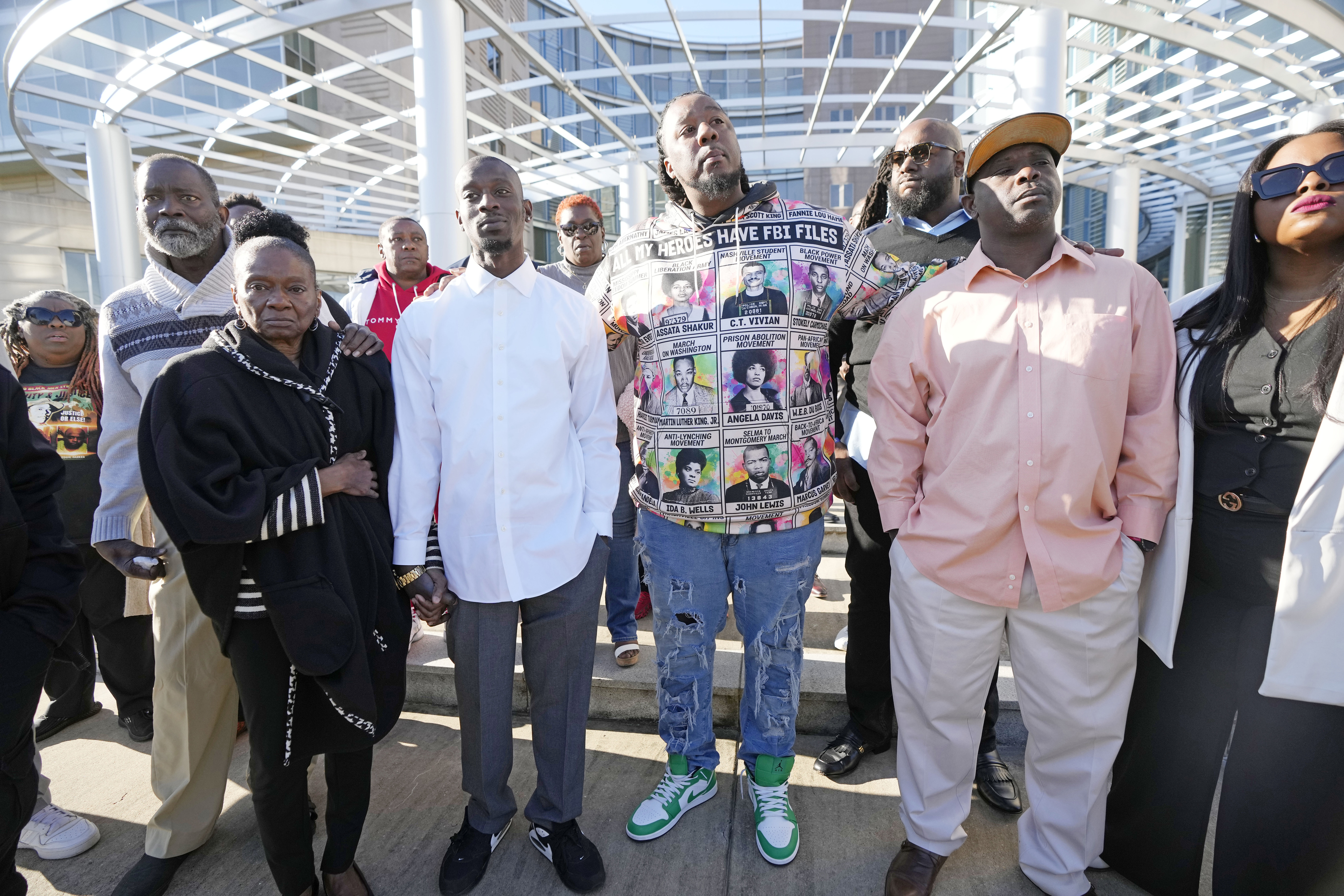
McAlpin and Middleton, the oldest in the group, threatened to kill other officers if they spoke up, prosecutors said. Opdyke was the first to admit what they did, according to Jeff Reynolds, his attorney. Opdyke showed investigators a WhatsApp text thread where the officers discussed their plan, Reynolds said.
The only defendant who didn’t receive a federal prison term at the top of the sentencing guidelines was Hartfield, who did not work in a sheriff’s department with the others and was not a member of the “Goon Squad.”
In federal court, the deputies expressed remorse for their behavior and apologized to Jenkins and Parker. Several of their attorneys said their clients became ensnared in a culture of corruption that was encouraged by leaders in the sheriff’s office.
Rankin County Sheriff Bryan Bailey revealed no details about his deputies’ actions when he announced they had been fired last June. After they pleaded guilty in August, Bailey said the officers had gone rogue and promised changes. Jenkins and Parker have called for his resignation and filed a $400 million civil lawsuit against the department.
- Share on Facebook Facebook
- Share on Twitter Twitter
- Share via Email Email
- Copy Link Copy Link Link Copied

STREAM FREE MOVIES, LIFESTYLE AND NEWS CONTENT ON OUR NEW APP

Mississippi Today
Pulitzer Prize-winning Nonprofit News
‘Goon Squad’ officers rack up state sentences in Mississippi torture case

Share this:
- Click to share on Twitter (Opens in new window)
- Click to share on Facebook (Opens in new window)
- Click to email a link to a friend (Opens in new window)
- Click to print (Opens in new window)

Nearly a month after being sentenced to federal prison for torturing and sexually assaulting two Black men and a third white man, six former Rankin County law enforcement officers known as the Goon Squad received state prison sentences Wednesday.
Rankin County Circuit Court Judge Steve Ratcliffe handed down prison sentences ranging from 10 to 20 years during a brief hearing.
“For many, many years, the Goon Squad has come into this courtroom and they have testified falsely against persons that they have beaten and caused to be wrongfully incarcerated,” Malik Shabazz, a lawyer representing two of the victims, said outside the courthouse.
“But today was dramatically different. Today, the judge in this circuit county court has given out justice to the Rankin County Goon Squad.”
Ratcliffe sentenced former patrol deputy Hunter Elward, who shot one of the men, to 20 years in state prison. Brett McAlpin, the former chief investigator, and Jeffrey Middleton, the lieutenant over the night shift known as the Goon Squad, were both sentenced to 15 years in state prison.

Former narcotics detective Christian Dedmon was sentenced to 20 years. Patrol deputy Daniel Opdyke and Richland narcotics investigator Joshua Hartfield got 15 years and 10 years, respectively.

Last month, the deputies all received federal prison terms ranging from nearly 18 years to 40 years. Hartfield received the shortest federal sentence – 10 years. The state sentences will run concurrently to the men’s federal sentences, meaning it’s unlikely any of the former officers will serve additional prison time.
The former officers will be required to turn in their state law enforcement certificates. They did not read statements during the hearing.
The five Rankin County deputies and the Richland police officer pleaded guilty last summer to state and federal charges for illegally raiding the home of Braxton residents Eddie Parker and Michael Jenkins in January 2023.

The officers handcuffed the men before beating them, hurling racial slurs and assaulting them with a sex toy.
Elward then shoved his gun into Jenkins’ mouth and pulled the trigger, shooting him through the neck and nearly killing him. The officers attempted to cover up their actions by planting drugs on the men, concocting a false narrative to justify the shooting and destroying evidence, according to a Justice Department investigation.
Dedmon, Elward and Opdyke also pleaded guilty for their roles in a separate torture incident in December 2022. After Rankin County deputies pulled over Alan Schmidt, they beat the man and shocked him with a Taser on the side of the highway. Dedmon fired his duty pistol to scare Schmidt, and threatened to dump his body in a nearby river.

Dedmon then sexually assaulted Schmidt, pressing his genitals against the man’s mouth and bare buttocks while he was handcuffed.
“These criminal acts make a difficult job even harder and far more dangerous,” MIssissippi Attorney General Lynn Fitch said in a statement. “And it is left to us all to commit ourselves to repairing that damage.”
Charges against Rankin County officers have so far been focused on these two incidents, but dozens of county residents say the sheriff’s department has routinely targeted drug users and minor drug dealers with similar levels of violence.

The New York Times and Mississippi Today published an investigation last fall revealing that deputies in the Rankin County Sheriff’s Department, many of whom called themselves the Goon Squad, routinely barged into homes in the middle of the night, handcuffed people and tortured them for information.
The deputies repeatedly shocked people with Tasers, assaulted a Hinds County sheriff’s deputy, waterboarded several men, dripped molten metal onto one man’s skin and beat several people until they were bloody and bruised, according to dozens of people who say they witnessed or experienced the raids.

Several of the people who said they experienced violence filed lawsuits or complained to the department. A few said they contacted Rankin County Sheriff Bryan Bailey directly, but were ignored.
Protesters have held rallies at the sheriff’s office and the Governor’s Mansion in recent weeks, renewing demands for Bailey to resign. Bailey, who did not respond to requests for comment for this story, has said he has no plans to step down.
Local activists said the sentences were another step toward accountability for a sheriff’s department that has long terrorized its residents.
“This chapter of the book has been written, but the book has not finished,” Angela English, president of the Rankin County chapter of the NAACP, said outside the courthouse. “There is much more to be done.”
After Wednesday’s hearing, a crowd of activists and local residents walked from the courthouse to the sheriff’s office through pouring rain, demanding to speak with Sheriff Bailey and calling for him to resign.
Department attorney Jason Dare, facing a barrage of forceful questions from the crowd,said he would try to schedule a meeting between residents and department representatives to discuss how to move forward together. The sheriff did not make an appearance.
The Rankin County district attorney’s office confirmed it was reviewing and dismissing criminal cases involving Goon Squad members, but District Attorney Bubba Bramlett has declined to share which cases have been dismissed or how far back in time his review will go.
The Mississippi House of Representatives and Senate recently passed a bill that would expand oversight over the state’s law enforcement, allowing the state board that certifies officers to investigate and revoke the licenses of officers accused of misconduct, regardless of whether they are criminally charged.
The bill is expected to land on the governor’s desk in the coming weeks after a final review by the House.
Republish This Story
Republish our articles for free, online or in print, under a Creative Commons license.
Republish this article

This work is licensed under a Creative Commons Attribution-NoDerivatives 4.0 International License .
- Look for the "Republish This Story" button underneath each story. To republish online, simply click the button, copy the html code and paste into your Content Management System (CMS).
- Editorial cartoons and photo essays are not included under the Creative Commons license and therefore do not have the "Republish This Story" button option. To learn more about our cartoon syndication services, click here .
- You can’t edit our stories, except to reflect relative changes in time, location and editorial style.
- You can’t sell or syndicate our stories.
- Any web site our stories appear on must include a contact for your organization.
- If you share our stories on social media, please tag us in your posts using @MSTODAYnews on Facebook and @MSTODAYnews on Twitter.
- You have to credit Mississippi Today. We prefer “Author Name, Mississippi Today” in the byline. If you’re not able to add the byline, please include a line at the top of the story that reads: “This story was originally published by Mississippi Today” and include our website, mississippitoday.org .
- You cannot republish our editorial cartoons, photographs, illustrations or graphics without specific permission (contact our managing editor Kayleigh Skinner for more information). To learn more about our cartoon syndication services, click here .
- Our stories may appear on pages with ads, but not ads specifically sold against our stories.
- You can only publish select stories individually — not as a collection.
by Nate Rosenfield and Brian Howey, Mississippi Today April 10, 2024
This <a target="_blank" href="https://mississippitoday.org/2024/04/10/goon-squad-officers-rack-up-state-sentences-in-mississippi-torture-case/">article</a> first appeared on <a target="_blank" href="https://mississippitoday.org">Mississippi Today</a> and is republished here under a Creative Commons license.<img src="https://i0.wp.com/mississippitoday.org/wp-content/uploads/2024/01/MT_icon-logo-favicon-1.png?fit=134%2C150&ssl=1" style="width:1em;height:1em;margin-left:10px;"><img id="republication-tracker-tool-source" src="https://mississippitoday.org/?republication-pixel=true&post=1114963&ga4=G-VSX4B701MS" style="width:1px;height:1px;">
Nate Rosenfield Investigative reporter
Nate Rosenfield is an investigative reporter at the Mississippi Center of Investigative Reporting at Mississippi Today, where he is working with The New York Times on a series on the abuse of power by sheriffs across Mississippi. A 2023 graduate of the Columbia University Graduate School of Journalism, he was a Stabile Investigative Fellow at Columbia Journalism School, where he completed an investigation into the impacts of heat illness on outdoor workers, which was published by the Guardian and Grist. He is the recipient of the Brown Institute's Magic Grant for his project Commons, a tool he and a team of data journalists are designing for investigative reporters that uses AI to analyze public comments on proposed federal regulations.
Brian Howey
Brian Howey is an award-winning investigative reporter at the Mississippi Center of Investigative Reporting at Mississippi Today. His stories have appeared in The New York Times, The Washington Post and the Los Angeles Times. His stories have also appeared in WIRED magazine. He earned his master’s degree at the UC Berkeley Graduate School of Journalism and has worked as a freelancer covering everything from policing to wedgefish.
Watch CBS News
Former Mississippi "Goon Squad" officers who tortured 2 Black men sentenced to decades in prison in state court
Updated on: April 10, 2024 / 11:24 AM EDT / CBS/AP
Six former Mississippi law enforcement officers were sentenced to decades in prison Wednesday in state court, after pleading guilty to a long list of state and federal charges for torturing and abusing two Black men . Rankin County Circuit Judge Steve Ratcliff gave the men state sentences that were shorter than the amount of time in federal prison that they had already received.
Brett McAlpin, a 53-year-old former high-ranking deputy, received a state sentence of 20 years. Joshua Hartfield, a 32-year-old former police officer, received 15 years. Christian Deldmon was sentenced to 25 years, Hunter Elward was sentenced to 45 years, and Jeffrey Middleton and Daniel Opdyke were sentenced to 20 years each.
The state sentences that came down on Wednesday were ordered to run concurrently, or at the same time, with their individual federal sentences , which each of the six men received at another hearing in March. McAlpin, Hartfield, Dedmon, Elward received about 27 years, 10 years, 40 years and 20 years imprisonment, respectively, for their federal convictions. In that federal hearing, U.S. District Judge Tom Lee sentenced Dedmon for his role in the group attack on Michael Corey Jenkins and Eddie Terrell Parker in January 2023, as well as another incident the December prior. Middleton and Opdyke both received 17 1/2 years imprisonment in federal court.
In March, U.S. District Judge Tom Lee called their actions "egregious and despicable" as he gave sentences near the top of the federal guidelines to five of the six men. The attack in 2023 involved beatings, repeated use of stun guns and assault with the sex toy, before one of the victims was shot in the mouth in a mock execution.

The case drew outrage from top law enforcement officials in the country, including Attorney General Merrick Garland, who said the officers committed a "heinous attack on citizens they had sworn an oath to protect." In the episode's grisly details, local residents saw echoes of Mississippi's history of racist atrocities by people in authority.
The first defendant to be sentenced Wednesday was Brett McAlpin, the fourth highest-ranking officer in the Rankin County Sheriff's Office. Weeks after he was sentenced by a federal judge to about 27 years of federal imprisonment, Brett McAlpin was sentenced in state court Wednesday to 15 years on one charge and five years on another.
Prior to the sentencing hearing, Malik Shabazz, an attorney representing Jenkins and Parker, said the state sentencing hearing would be a "test" for Ratliff and state prosecutors.
"The state criminal sentencing is important because historically, the state of Mississippi has lagged behind or ignored racial crimes and police brutality against Blacks, and the Department of Justice has had to lead the way," Shabazz said.
The defendants include five former Rankin County sheriff's deputies — Brett McAlpin, 53, Hunter Elward, 31, Christian Dedmon, 29, Jeffrey Middleton, 46, and Daniel Opdyke, 28 — and a former police officer from the city of Richland, Joshua Hartfield, 32, who was off duty during the assault.

All six of the former officers pleaded guilty to state charges of obstruction of justice and conspiracy to hinder prosecution. Dedmon and Elward, who kicked in a door, also admitted to home invasion.
The charges followed an Associated Press investigation in March that linked some of the officers to at least four violent encounters since 2019 that left two Black men dead.
The former lawmen admitted to breaking into a home without a warrant and torturing Jenkins and Parker in an hourslong attack that included beatings, repeated uses of stun guns and assaults with a sex toy before one of the victims was shot in the mouth.
The terror began on Jan. 24, 2023, with a racist call for extrajudicial violence, according to federal prosecutors.
A white person phoned Rankin County Deputy Brett McAlpin and complained that two Black men were staying with a white woman at a house in Braxton, Mississippi. McAlpin told Christian Dedmon, who texted a group of white deputies so willing to use excessive force they called themselves "The Goon Squad."
Once inside, they handcuffed Jenkins and his friend Parker and poured milk, alcohol and chocolate syrup over their faces while mocking them with racial slurs. They forced them to strip naked and shower together to conceal the mess. They mocked the victims with racial slurs and assaulted them with sex objects.
In a mock execution gone awry, Elward shot Jenkins in the mouth, lacerating his tongue and breaking his jaw. The officers devised a coverup and agreed to plant drugs on Jenkins and Parker. False charges stood against the men for months.
McAlpin and Middleton, the oldest in the group, threatened to kill other officers if they spoke up, prosecutors said. Opdyke was the first to admit what they did, according to Jeff Reynolds, his attorney. Opdyke showed investigators a WhatsApp text thread where the officers discussed their plan, Reynolds said.
The only defendant who didn't receive a federal prison term at the top of the sentencing guidelines was Hartfield, who did not work in a sheriff's department with the others and was not a member of the "Goon Squad."
In federal court, the deputies expressed remorse for their behavior and apologized to Jenkins and Parker. Several of their attorneys said their clients became ensnared in a culture of corruption that was encouraged by leaders in the sheriff's office.
Rankin County Sheriff Bryan Bailey revealed no details about his deputies' actions when he announced they had been fired last June. After they pleaded guilty in August, Bailey said the officers had gone rogue and promised changes. Jenkins and Parker have called for his resignation and filed a $400 million civil lawsuit against the department.
- Mississippi
- Police Officers
- Merrick Garland
More from CBS News

James and Jennifer Crumbley, parents of Oxford High School shooter, sentenced


Utah man sentenced after seeking hitman to kill parents of kids he adopted

Fugitive police officer arrested in killing of student in Mexico

Chad Daybell's "desire for sex, money and power" led to deaths, prosecutor says
The Mississippi sheriff whose ranks included a 'Goon Squad' needs to go
Six former law enforcement officers in Mississippi — five of whom were in the Rankin County Sheriff’s Office’s self-titled “Goon Squad” — got sentences ranging from 15-45 years Wednesday for their confessed roles in a 90-minute torture session that included them assaulting two Black men with a sex toy and punching and kicking them as they called them racial slurs. One of the six, Hunter Elward , forced his gun into the mouth of Michael Corey Jenkins and fired a round, lacerating the man’s tongue and breaking his jaw. It seems nothing less than a miracle that the victims — Jenkins in particular — survived and were able to convey their anguish to the court Wednesday.
It seems nothing less than a miracle that the victims — Jenkins in particular — survived and were able to convey their anguish to the court Wednesday.
“They left me to die bleeding on the floor, and they set me up to be imprisoned,” Jenkins said in a statement that, because he still has trouble speaking, was read Wednesday by his attorney. “Your honor, they killed me,” Jenkins said in his statement. “I just didn’t die.” Eddie Parker, who was tortured alongside him that night, said, “I don’t know if I’ll ever be able to sleep again at night.” He said that “the humiliation and embarrassment from the sexual assault is too great for me to talk about.”
As satisfying as it may have been to see the officers sentenced again — they were sentenced following their guilty pleas to federal charges last month — their being sent to prison should not be where this story ends. That’s why it was only right that after former Rankin County sheriff’s deputies Brett Morris McAlpin, 53; Christian Dedmon, 29; Jeffrey Middleton, 46; 31-year-old Elward; Daniel Opdyke, 28, and former Richland Police Officer Joshua Hartfield, 32, were sentenced Wednesday that the focus returned to demanding the resignation of Rankin County Sheriff Bryan Bailey .
The sheriff said the officers had lied to him about the night they barged into a home without a warrant — responding to a phone call from a white person who said the two Black men were entering a white woman’s home — and sexually tortured the men. (After Elward fired his gun into Jenkins’ mouth — he apparently thought it was unloaded — the officers planted methamphetamine and a gun on the pair and accused them of drug possession.) The sheriff professes to have been shocked to learn of the existence of the Goon Squad. But John C. Barnett, a civil rights attorney who’s demanding the sheriff’s resignation, told the Mississippi Free Press after Wednesday’s sentencing hearing, “ We’d be fools to think ” Bailey “didn’t know anything about the ‘goon squad.’”
We might also be fools if we think the sheriff will ever be held accountable for atrocities that happened on his watch. He’d already served as sheriff for 12 years and was re-elected in November — that is, almost nine months after the U.S. Justice Department announced that it was investigating a possible civil rights violation by his department and three months after five of his former deputies and the Richland police officer pleaded guilty to 16 federal charges , including civil rights conspiracy, deprivation of rights under color of law, discharge of a firearm during a crime of violence, conspiracy to obstruct justice and obstruction of justice. Bailey wasn’t just re-elected, he was re-elected without opposition.
The only thing I’m guilty of is trusting grown men that swore an oath to do their job correctly. I’m guilty of that.
rankin county sheriff bryan bailey
“ The only thing I’m guilty of is trusting grown men that swore an oath to do their job correctly,” he said after his deputies pleaded guilty to federal charges in August 2023. “I’m guilty of that.” However, about four months after that statement from Bailey , Mississippi Today (as part of a series by The New York Times’ Local Investigations Fellowship ) published a story based on interviews with more than 50 people who either experienced or witnessed the Goon Squad’s torture. Many of the people interviewed, the news outlet reported, had filed formal complaints or lawsuits against the Goon Squad’s officers.
The outlet reported that a smaller number of those interviewed, including a sheriff’s deputy from a neighboring county, reported having talked directly to Bailey about the unit’s brutality. That deputy, who was jailed for six months and lost his job (he was never convicted), told Mississippi Today that Bailey accused him of being a dirty cop and of secretly recording the call and then, “ He hung up on me .”
How did Bailey miss the challenge coins the Goon Squad had the audacity to create to celebrate itself? They even embossed those coins with the name of Middleton , the now-imprisoned former lieutenant who led them.

When Mississippi Today pointed out that “several high-ranking deputies” had been “involved in arrests that had sparked accusations of brutal treatment,” the outlet says he responded, “ I have 240 employees , there’s no way I can be with them each and every day.”
At the same press conference where he said the officers who attacked Jenkins and Parker had lied to him, Bailey said, “I’m going to stay here. I’m not going to resign . I’m going to fix these problems,” and, he said, leave the department “ in better shape than I found it.”
There was a brief moment after Minneapolis police murdered George Floyd when it seemed America was mortified at the idea of coldly sadistic police . But maybe the country was just embarrassed that Floyd’s life was snuffed out on camera and in front of so many witnesses. Or maybe the theory that many people were fueled by pent-up pandemic energy is valid . But, clearly, Jenkins, who had a police officer fire a bullet into his mouth, could have been every bit as dead as Floyd. The fact that nobody even ran against a sheriff who had such a perversely violent group of officers on his payroll suggests that too many people are OK with their law enforcement officers acting like outlaws. At least when there isn’t video.
There was a brief moment after Minneapolis police murdered George Floyd when it seemed America was mortified at the idea of coldly sadistic police.
Though Jenkins and Parker are Black and all the officers who’ve been sentenced for assaulting them are white, Mississippi Today found that most of the people who’ve accused the “Goon Squad” of misconduct are white. Still, there’s no way around the fact that they sexually humiliated and tortured the Black men because, as Jenkins put it Wednesday, “we were accused of dating white women.”
It just so happens that, as The Associated Press reported, “ Parker was a childhood friend of the homeowner , Kristi Walley, who was at the hospital at the time. She’s been paralyzed since she was 15, and Parker was helping care for her.”
That fact doesn’t make Jenkins and Parker more innocent — because interracial sex isn’t an offense. But one does hope these goons spend the entirety of their confinement not only feeling remorseful for their crimes, but also feeling stupid that there wasn't even a white damsel whose honor needed defending.
Jarvis DeBerry is an opinion editor for MSNBC Daily.
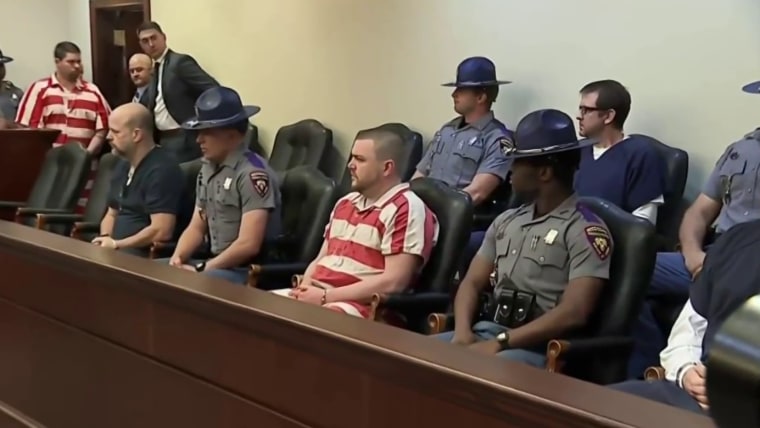
Tax tips: What you need to know before the federal filing deadline

Harris to speak on reproductive rights in Arizona after abortion ruling

Northwestern students develop pen for people with Parkinson’s disease

Evidence missing in Virginia shooting investigation involving 6-year-old student, attorney says

Charges filed against former interpreter of Dodgers star Ohtani

Stranded sailors rescued after spelling 'HELP' with palm leaves

Missouri death row inmate executed despite calls for clemency

EPA announces new rules targeting 'forever chemicals'

Mississippi 'Goon Squad' members sentenced for torturing Black men

Arizona Gov. Hobbs speaks out against near-total abortion ban ruling

Cozy cardio reinvents workouts through comfortable routines

Arizona Supreme Court upholds near-total abortion ban

Parents of Michigan school shooter sentenced to 10-15 years for involuntary manslaughter
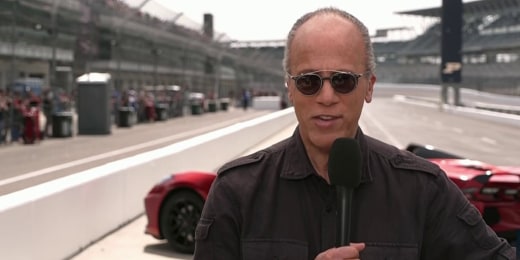
Thousands pack Indianapolis Motor Speedway to view eclipse

Natural reactions: How animals may behave during the eclipse

Woman accuses son of Sean 'Diddy' Combs of sexual assault

USGS expert explains how geology of Northeast affects intensity of earthquakes
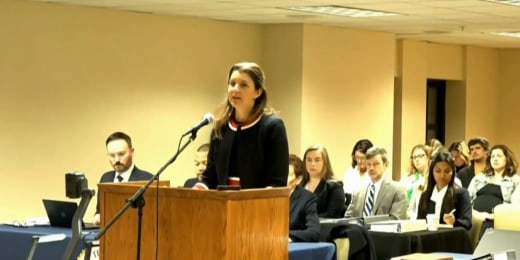
Tennessee court hears case on medical exception rules for abortions
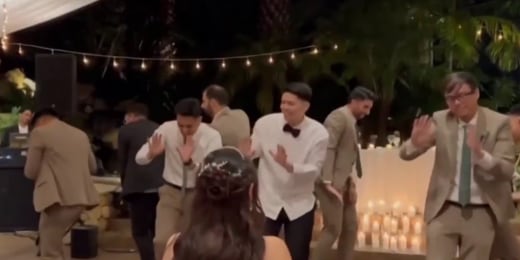
Groomsmen spend months preparing for surprise wedding dance

What is a total solar eclipse?
Nbc news now, mississippi 'goon squad' members sentenced for torturing black men.
Six former Mississippi law enforcement officers who were part of a self-proclaimed "goon squad" have been sentenced to prison for torturing two black men during a 2023 interrogation. April 10, 2024
Best of NBC News

NBC News Channel
Oakland city officials vote to include 'san francisco' in airport's name.

Texas doctor accused of manipulating transplant lists

Record-breaking rain causes flash flooding in Pittsburgh

What you need to know ahead of Trump's New York hush money trial

A Visit from the Goon Squad
Jennifer egan, ask litcharts ai: the answer to your questions.
Time and Memory
A Visit from the Goon Squad serves as an in depth exploration of the passage of time, the effects of aging on individual lives, and the longing for the past through memory. The novel’s title even speaks directly to the theme of time. Bosco , the former guitarist of The Conduits, who has become fat, alcoholic, and suicidal, states, “Time’s a goon, right?” Traditionally, a goon was an individual who inflicts fear and violence on…
Identity, Authenticity, and Meaning
The issue of identity is a prominent theme in A Visit from the Goon Squad , as Egan explores the extent to which identity is inherent and the ways in which it is assumed. The novel’s characters struggle to find meaning and authenticity in their lives, and they use different methods to discover, create, and escape their identities. The novel’s two primary characters, Sasha and Bennie , are two examples of characters that face challenges…
Connection, Disconnection, and Technology
The theme of Connection and Disconnection is finely balanced in Egan’s novel. Structurally, the novel highlights the way in which the characters’ lives are woven together. Characters from one story emerge in later stories as background characters, and background characters in some stories take center stage at other points in the novel. For example, the story “Ask Me if I Care” is narrated by Rhea and includes Jocelyn as a side character. Later in the…
Fame, Art, and Popular Culture
A Visit from the Goon Squad offers a strong critique of popular culture. Egan accomplishes this criticism primarily through her exploration of the music industry, but film, photography, and journalism are also investigated in her novel. Egan draws attention to the way in which trends come and go, and the effects of these cultural shifts. What is popular in one moment—for example, punk rock—is replaced by another trend soon after—such as overproduced pop music or…
Ruin and Redemption
The theme of ruin and redemption is present throughout Egan’s novel. This theme fits nicely alongside the novel’s other themes, as the characters find themselves crushed by time, by their self-centered and isolating ways of living, and by shifts in American culture. Throughout the novel, each of the major characters finds him- or herself at a low point. Sasha ’s story shows her slipping deeper into ruin as the result of her stealing, her isolation…
6 former Mississippi law officers sentenced in state court for torture of 2 Black men

BRANDON, Miss. (AP) — Already sentenced to federal prison, six former Mississippi law enforcement officers who pleaded guilty to a long list of state and federal charges for torturing two Black men were sentenced Wednesday in state court.
The six white former Mississippi law enforcement officers who attacked Michael Corey Jenkins and Eddie Terrell Parker in January 2023 had already been sentenced to federal prison terms ranging from about 10 to 40 years. In March, U.S. District Judge Tom Lee called their actions “egregious and despicable” as he gave sentences near the top of the federal guidelines to five of the six men.
Rankin County Circuit Judge Steve Ratcliff on Wednesday gave the men yearslong state sentences that were shorter than the amount of time in federal prison that they had already received. Time served for the state convictions will run concurrently, or at the same time, as the federal sentences, and the men will serve their time in federal penitentiaries.
The case drew outrage from top law enforcement officials in the country, including Attorney General Merrick Garland, who said the officers committed a “heinous attack on citizens they had sworn an oath to protect.” In the episode’s grisly details, local residents saw echoes of Mississippi’s history of racist atrocities by people in authority.
The first defendant to be sentenced Wednesday was Brett McAlpin, the fourth highest-ranking officer in the Rankin County Sheriff’s Office. McAlpin had previously been sentenced by a federal judge to about 27 years of federal imprisonment. He was sentenced in state court Wednesday to 15 years on one charge and five years on another.
Prior to the sentencing hearing, Malik Shabazz, an attorney representing Jenkins and Parker, said the state sentencing hearing would be a “test” for Ratliff and state prosecutors.
“The state criminal sentencing is important because historically, the state of Mississippi has lagged behind or ignored racial crimes and police brutality against Blacks, and the Department of Justice has had to lead the way,” Shabazz said.
The defendants include five former Rankin County sheriff’s deputies — McAlpin, 53; Hunter Elward, 31; Christian Dedmon, 29; Jeffrey Middleton, 46; and Daniel Opdyke, 28 — and a former police officer from the city of Richland, Joshua Hartfield, 32, who was off duty during the assault.
All six of the former officers pleaded guilty to state charges of obstruction of justice and conspiracy to hinder prosecution. Dedmon and Elward, who kicked in a door, also admitted to home invasion.
The charges followed an Associated Press investigation in March that linked some of the officers to at least four violent encounters since 2019 that left two Black men dead.
The former lawmen admitted to breaking into a home without a warrant and torturing Jenkins and Parker in an hourslong attack that included beatings, repeated uses of stun guns and assaults with a sex toy before one of the victims was shot in the mouth.
The terror began on Jan. 24, 2023, with a racist call for extrajudicial violence, according to federal prosecutors.
A white person phoned Rankin County Deputy Brett McAlpin and complained that two Black men were staying with a white woman at a house in Braxton, Mississippi. McAlpin told Christian Dedmon, who texted a group of white deputies so willing to use excessive force they called themselves “The Goon Squad.”
Once inside, they handcuffed Jenkins and his friend Parker and poured milk, alcohol and chocolate syrup over their faces while mocking them with racial slurs. They forced them to strip naked and shower together to conceal the mess. They mocked the victims with racial slurs and assaulted them with sex objects.
In a mock execution gone awry, Elward shot Jenkins in the mouth, lacerating his tongue and breaking his jaw. The officers devised a coverup and agreed to plant drugs on Jenkins and Parker. False charges stood against the men for months.
McAlpin and Middleton, the oldest in the group, threatened to kill other officers if they spoke up, prosecutors said. Opdyke was the first to admit what they did, according to Jeff Reynolds, his attorney. Opdyke showed investigators a WhatsApp text thread where the officers discussed their plan, Reynolds said.
The only defendant who didn’t receive a federal prison term at the top of the sentencing guidelines was Hartfield, who did not work in a sheriff’s department with the others and was not a member of the “Goon Squad.”
In federal court, the deputies expressed remorse for their behavior and apologized to Jenkins and Parker. Several of their attorneys said their clients became ensnared in a culture of corruption that was encouraged by leaders in the sheriff’s office.
Rankin County Sheriff Bryan Bailey revealed no details about his deputies’ actions when he announced they had been fired last June. After they pleaded guilty in August, Bailey said the officers had gone rogue and promised changes. Jenkins and Parker have called for his resignation and filed a $400 million civil lawsuit against the department.
Want more WLBT news in your inbox? Click here to subscribe to our newsletter.
See a spelling or grammar error in our story? Please click here to report it and include the headline of the story in your email.
Copyright 2024 WLBT. All rights reserved.

Nurse drowns after driving into flooded Mississippi highway

O. J. Simpson dies at age 76, family says

Two ‘beloved staff members’ injured after incident at Bolivar Co. elementary school

Amarillo missing woman found alive after 13 years

Murder suspect in connection with deadly Parkway Drive shooting in custody following police chase
Latest news.

Second Richard’s Disposal lawsuit against Jackson has been dismissed
Murder suspect in parkway drive shooting denied bond in municipal court.

‘It’s been fantastic’: Students from Blind and Deaf Schools participate in local arts program

Winners announced in Egg Marketing Board Easter Coloring Contest

Man shot and killed near Jackson elementary school
Former Mississippi officers known as the 'Goon Squad' sentenced on state charges
- Medium Text
Jumpstart your morning with the latest legal news delivered straight to your inbox from The Daily Docket newsletter. Sign up here.
Reporting by Brendan O'Brien in Chicago Editing by Bill Berkrot
Our Standards: The Thomson Reuters Trust Principles. New Tab , opens new tab
Read Next / Editor's Picks

Industry Insight Chevron

Mike Scarcella, David Thomas

Karen Sloan

Henry Engler

Diana Novak Jones

IMAGES
COMMENTS
In 'A Visit from the Goon Squad,' characters like Sasha Blake and Bennie Salazar play central roles, embodying the novel's diverse time-spanning narrative. ... Drew meets Sasha in college, and the pair would later get married and have two children. He is one of the good guys, ambitious, and a long-time admirer of Sasha while both were in ...
A Visit from the Goon Squad is a 2011 Pulitzer Prize-winning work of fiction by American author Jennifer Egan. The book is a set of thirteen interrelated stories with a large set of characters all connected to Bennie Salazar, a record company executive, and his assistant, Sasha. ... and Drew, now Sasha's boyfriend, spend a winter night partying ...
The autistic child of Sasha and Drew, Lincoln is obsessed with pauses in great rock and roll songs. He is intelligent, but socially awkward. He fails to relate to his father, but eventually finds connection through a project they do that involves graphing pauses in rock and roll music.
A Visit from the Goon Squad Summary. A Visit from the Goon Squad is unconventional in the way its narrative unfolds. Each chapter stands as a self-contained story, but as a whole, the individual episodes create connections that form a cohesive narrative. The stories, as they appear in the novel, do not follow a traditional chronology.
Summary. Analysis. This chapter is delivered in the form of a PowerPoint presentation created by Sasha 's 12-year-old daughter, Alison. It describes the events of May 14th and 15th of some year in the 2020s. There are four sections, titled "After Lincoln 's Game," "in Alison's room," "one night later," and "the desert.".
When Sasha meets Drew, she forgets about her father's supposed detective. (Out of Body 148) Drew goes swimming in the East River, Rob follows him in, drowns. (Out of Body 155) Drew becomes a doctor because of Rob. (Great Rock and Roll Pauses 214) Marries Sasha. She left New York and met him overseas.
The A Visit from the Goon Squad Community Note includes chapter-by-chapter summary and analysis, character list, theme list, historical context, author biography and quizzes written by community members like you. ... Drew accuses Rob of lying and dives into the frigid water of the East River. Rob goes after, but never comes back up. Chapter 11:
Egan's ' A Visit from the Goon Squad ' came in June 2010 as the author's fourth book after ' The Invisible Circus ,' ' Look at Me, ' and ' The Keep.'. The book took a non-conventional approach in the genre, narrative style, characters, and technique, exploring the passage of time (how time just never stops for anyone) - in ...
Check. Although shredded with loss, "A Visit From the Goon Squad" is often darkly, rippingly funny. Egan possesses a satirist's eye and a romance novelist's heart. Certainly the targets ...
Jennifer Egan is the author of four novels: A Visit from the Goon Squad , The Keep, Look at Me, The Invisible Circus; and the story collection Emerald City. Her stories have been published in The New Yorker, Harper's Magazine, GQ, Zoetrope, All-Story, and Ploughshares, and her nonfiction appears frequently in The New York Times Magazine.
I n 2010, Jennifer Egan published A Visit From the Goon Squad.The novel won the Pulitzer Prize and the National Book Critics Circle Award, suggesting esteem among populists and highbrows alike ...
Sasha. When she first appears in A Visit from the Goon Squad, Sasha is in therapy for her kleptomania, having lost her job and her friends, presumably as a result of her condition. We eventually learn that she has had an abusive childhood and her adolescence involved self-destructive behavior. She runs away at seventeen and travels the world ...
One of The Atlantic's Great American Novels of the Past 100 Years. Bennie is an aging former punk rocker and record executive. Sasha is the passionate, troubled young woman he employs. Here Jennifer Egan brilliantly reveals their pasts, along with the inner lives of a host of other characters whose paths intersect with theirs. "Pitch ...
Abstract. In this article, I argue that Jennifer Egan's A Visit from the Goon Squad (2010) and Dana Spiotta's Eat the Document (2006) use music as a way to problematize postmodern approaches to history and temporality. Using Giorgio Agamben's model of "the contemporary," I argue that Egan and Spiotta stage an intergenerational dialogue by contrasting the listening habits of parents ...
A Visit from the Goon Squad is a 2011 Pulitzer Prize-winning work of fiction by American author Jennifer Egan. The book is a set of thirteen interrelated stories with a large set of characters all connected to Bennie Salazar, a record company executive, and his assistant, Sasha. The book centers on the mostly self-destructive characters of different ages who, as they grow older, are sent in ...
A Visit from the Goon Squad by Jennifer Egan - review. T he title of Jennifer Egan's new novel may make it sound more like an episode of Scooby-Doo than an exceptional rendering of contemporary ...
Analysis. This story is told in the second person by a character named Rob. While hanging out at a friend's house, Rob listens to his friend Drew talk about being president one day. He looks at Drew through layers of hash smoke in the sun. Drew's arm is around Sasha. Rob admires Drew's body, which is healthy because of his love of swimming.
The six white former Mississippi law enforcement officers who attacked Michael Corey Jenkins and Eddie Terrell Parker in January 2023 had already been sentenced to federal prison terms ranging ...
Brett McAlpin, the former chief investigator, and Jeffrey Middleton, the lieutenant over the night shift known as the Goon Squad, were both sentenced to 15 years in state prison. Hunter Elward was sentenced to 20 years in Rankin County Court, Wednesday, April 10, 2024 in Brandon, Miss. Credit: Vickie D. King/Mississippi Today.
Mississippi "Goon Squad" officers sentenced for torturing Black men 06:19. ... The case drew outrage from top law enforcement officials in the country, including Attorney General Merrick Garland ...
The six former Mississippi law enforcement officers who tortured and abused two Black men in a racist attack were sentenced on Wednesday to 15 to 45 years in prison on state charges. The men ...
03:10. April 11, 2024, 9:06 AM PDT. By Jarvis DeBerry, MSNBC Opinion Editor. Six former law enforcement officers in Mississippi — five of whom were in the Rankin County Sheriff's Office's ...
Six former Mississippi law enforcement officers who were part of a self-proclaimed "goon squad" have been sentenced to prison for torturing two black men during a 2023 interrogation.April 10, 2024 ...
The Goon Squad. 5:21. Six former Rankin Co. officers plead guilty to charges related to abuse of Black men. 2:20. Members of 'Rankin County Six' no stranger to allegations of civil rights violations, assault. 3:12. Activists call for Rankin Co. Sheriff to resign after officers beat, torture two Black men. 3:08.
A Visit from the Goon Squad offers a strong critique of popular culture. Egan accomplishes this criticism primarily through her exploration of the music industry, but film, photography, and journalism are also investigated in her novel. Egan draws attention to the way in which trends come and go, and the effects of these cultural shifts.
The case drew outrage from top law enforcement officials in the country, including Attorney General Merrick Garland, who said the officers committed a "heinous attack on citizens they had sworn an oath to protect." In the episode's grisly details, local residents saw echoes of Mississippi's history of racist atrocities by people in ...
Six white former Mississippi law enforcement officers received sentences ranging from 10 to 45 years in prison on Wednesday on state charges for their roles in the "Goon Squad" torture and sexual ...